Célébrons la beauté et le pouvoir de l'art

Thème du prix d’art de la Société canadienne de la douleur 2026 : « Ressentir la douleur »
Voyagez à travers les récits entrelacés de personnes ayant une expérience de la douleur persistante, de chercheurs, de cliniciens, de stagiaires, de décideurs politiques et de soignants. Leurs espoirs, leurs besoins et leurs efforts dévoués prennent vie dans chaque pièce. Grâce à l'art, nous ne nous contentons pas de promouvoir la compréhension, nous inspirons l'action.
Alerte : L'art nous permet à chacun l'opportunité d'explorer les sujets difficiles de différentes manières. Pour cette raison, quelques œuvres d'art incluses dans cette exposition virtuelle - ou bien dans leurs descriptions - abordent des thèmes de fin de vie, de santé mentale, de nudité et de la reproduction humaine, et de la souffrance qui pourraient déranger quelques visiteurs.
Category Winner [2021]
Lady in Pain
Lizbeth Ayoub
She is one of us; a woman exposed to the invasive nature of pain. More women than men suffer from chronic pain. Chronic pain perseveres, overwhelms the body, mind and blurring one’s identity with oneself and society. Its dark web leaves one vulnerable, exposed, and subjected to its intensity. Yet, this lady stands tall, graceful in the face of adversity. Her golden head is a symbol of knowledge and future brain research for new treatments.
Category Winner [2021]
Like a Buzzing Mosquito, Chronic Pain is Impossible to Ignore.
Sandra Woods
This abstract mosquito represents the ever-present burden of chronic pain. If you’ve ever tried to fall asleep with a mosquito in your room, you know how distracting and even distressing it can seem!Chronic pain is much worse, buzzing its way into your mind and intruding in your thoughts. Pain makes it hard to concentrate at school, at work, or even on fun activities. Chronic pain can also be menacing, because we expect our bodies to use pain to tell us that something is wrong.
Appendicitis, kidney stones, labour pains – these kinds of pain signals are the body’s internal alarms, telling us to get medical help!
In chronic pain though, the body’s pain alarm stays on – all the time – even after any injury has healed, or sometimes for no obvious reason.
Not only is that mosquito buzzing around you all the time, imagine feeling that it is constantly biting you… when it isn’t.
Chronic pain is much worse than a mosquito bite, of course, but I’m sure you get the idea!
Even though we’d like to swat pain away, like a mosquito, much more research is needed to make that possible.
In the meantime, many people live with constant and long-term pain.
Like a menacing mosquito, hovering constantly over your head for months, years, or even decades
Category Winner [2022]
The Colors of the Pain Experience
Louise Castillo
Chronic pain colors many aspects of one’s life. It shades one’s work, relationships, and self-care, leading to suffering and for some, loss of employment, physical mobility, and identity.
Living with pain is emotionally stressful; some may feel trapped by their own thoughts and/or immersed in a cycle of avoidant behaviors with an aim to reduce their pain. Pain can limit a life previously known across the lifespan—an experience that can be devastatingly isolating. Yet, in the midst of that, many live through the daily peaks and pitfalls of the totality of the pain experience–experiencing a host of other emotions colored by strength and resilience in the face of adversity.
Category Winner [2022]
Displacement
Chloe Fleisher
I am a 13-year girl who has lived with chronic pain for more than 5 years. I drew this image to express how I sometimes feel when I'm in pain -like I am drowning or submerged. The pain consumes my whole body. I am helpless and there is nothing I can do to stop the suffering or to help myself.
Note: The art work was submitted by the parent of a child with chronic pain and medical complexity. The author of the art submission is her 13 year old daughter Chloe Fleisher
Category Winner [2022]
Turning to Stone
Terry Wilde
My late wife Lili Painted this in 2003 after full body Chronic Regional Pain Syndrome (CRPS) set in, triggered by a car accident in 1999. She had full-bodied Pain except in the left side of her face. At this point in her life she had no tolerated pain medications due to severe allergies. Suicide or Medically Assisted Death was a constant battle.
This Image depicts the struggle with pain and loss of ability, while showing the life in the left side of her face, the one place she could escape to. After many years of struggle and Healthcare Harm, she died in 2019 with a strong will to live.
Deuxième
Pain, Delirium, and the Jungle Within
Noor Al Kaabi
This artwork captures the visceral experience of pain and delirium in the intensive care unit (ICU). A woman lies in her hospital bed, her skin flushed red, symbolizing agony the body’s distress under illness and medical intervention. Her hair transforms into a dense and tangled jungle — her mind is both sanctuary and a nightmare.
Through this piece, I explore the delicate balance between alleviating suffering and the cognitive consequences of sedation. The question “What do I do for pain?” is not only personal but deeply ethical. Physicians are tasked with understanding the evolving landscape of pain management. Recent evidence favors multimodal pain relief strategies over excessive sedation to reduce ICU delirium and cognitive impairment. The historical reliance on benzodiazepines is waning, while non-pharmacologic interventions such as early mobility gain favour.
This piece invites the viewer to step into this complex intersection of medicine, ethics, and human vulnerability—where every decision carries consequences, and relief is often inseparable from consequences.
First [2023]
Kept Hidden
Tarannum Rahnuma
My piece aims to capture the lived experiences of those with chronic pain, which affects approximately 1 in 5 Canadians. The daily struggle of managing chronic pain can make even the simplest tasks challenging, particularly in social situations where individuals may feel pressured to conceal their symptoms to avoid being stigmatized or perceived as a burden. My painting captures the emotional and physical toll of masking pain in social settings, particularly during happy occasions such as celebrations.
Through "Kept Hidden", I hope to foster greater empathy and understanding of the experiences of those living with chronic pain. I believe that by raising awareness and encouraging dialogue, we can create a more supportive and inclusive society that recognizes the challenges faced by those with pain.
First [2024]
Planting Seeds in the Wind
Ezinne Ekediegwu
Within this evocative artwork lies a profound narrative that encapsulates the enduring struggle of a patient suffering from endometriosis, whose existence is characterized by persistent pain and weakness. Through her poignant portrayal, the artist conveys the individual's unwavering commitment to raising awareness and fostering understanding of this debilitating disease within her challenging societal context.
The central figure, adorned in traditional Nigerian attire, serves as a poignant representation of the broader societal challenges faced by individuals grappling with endometriosis in Nigeria. The deep crimson hue of her garments symbolizes the profound suffering endured and perpetuated by the disease. With a hand firmly clasped to her abdomen, the locus of her anguish, she endeavours to scatter seeds into the wind. These seeds serve as potent symbols of her tireless efforts to sow awareness and enlightenment regarding her condition. Yet, the wind itself serves as a metaphor for the societal currents that buffet her efforts, for the prevailing ignorance and indifference that shroud endometriosis within her community.
Indeed, statistics reveal a staggering reality: one in ten women are afflicted by endometriosis, yet awareness remains alarmingly scarce. In Nigeria, the dearth of specialized medical practitioners exacerbates the plight, with no more than two Endometriosis specialists navigating the complex terrain of this condition. Globally, the paucity of knowledge and the absence of a definitive cure cast a shadow over the lives of countless individuals.
The tragic narrative continues with accounts of medical practitioners dismissing patients' symptoms as imaginary, prescribing ineffective treatments, and even subjecting sufferers to ridicule and mockery. Consequently, delayed diagnoses and preventable tragedies ensue, perpetuating a cycle of suffering and despair.
Yet, amidst the darkness, a beacon of hope emerges. Through her resolute advocacy and unwavering determination, the protagonist endeavours to illuminate the shadows shrouding endometriosis. Her indomitable spirit serves as a rallying cry, compelling society to confront its collective ignorance and apathy. Thus, through her courageous crusade, she endeavours to sow the seeds of awareness and understanding, nurturing a brighter future for generations to come.
Première
Blooms on Neural Threads
Monika Kataria
This artwork represents the shared journey of people living with chronic pain and the caregivers, researchers, and clinicians who support them. The vibrant blooming flowers symbolize resilience and growth, while the small human figures seated within the petals capture deeply human moments of introspection and vulnerability experienced by people living with pain. The delicate neuron threads interwoven throughout highlight the vital role of researchers and medical professionals, whose efforts provide understanding, connection, and hope to those navigating pain. These threads nurture the blooms, reflecting the collective compassion and empathy that drives healing and progress. This piece celebrates the strength and humanity of those impacted by pain and the enduring power of unity.
Troisième
Shackles of White Ribbon
Rimsha Malik
In "Shackles of White Ribbon", pain is both a constraint and a catalyst for resilience. The white ribbons—tight and restrictive—reflect the coping mechanisms and facades we adopt to contain pain, even when they confine our freedom and authenticity. Yet, within this restriction, there’s a quiet strength, as if these "shackles" keep the pieces from unraveling entirely.
The hand partially covering the face represents the instinct to shield oneself, to conceal the raw vulnerability that pain exposes. However, the piercing gaze challenges this, suggesting a confrontation with pain rather than retreat. The swirling background embodies the inner turmoil—waves of anguish and resilience intermingling—showing that pain is not a static experience but an ever-shifting force.
Through this self-portrait, pain is endured, hidden, battled, and ultimately embraced as part of oneself. The painting answers: what do I do for pain? I live with it, I confront it, and I transform it into art.
Félicitations à nos gagnants de 2025 !
Unseen Struggles, Shared Horizons
Rangana Hetti Arachchige
“Unseen Struggles, Shared Horizons” is a visual journey through the hidden realities of chronic pain in Canada. From the relentless toll on trades workers to young adults lost in the transition between care systems, from aging bodies bearing decades of discomfort to the silent suffering of those without stable housing—pain is everywhere, yet too often ignored. Each image captures a moment of endurance, isolation, and resilience, reflecting the systemic gaps that leave many without adequate support. But pain is not just an individual experience; it is a shared reality that demands collective action. This collection invites viewers to see beyond the surface, to recognize the humanity in suffering, and to imagine a future where pain care is equitable and accessible for all. Through these images, I ask: What do we do for pain? And more importantly, what can we do together?
Patient
Cassandra Myers
Patient is a spoken word-dance video created for the UBC H.E.A.L Project which instructed doctors how to better treat their patients with chronic pain. The video details my lived experience with chronic pain alongside my chronic pain dance.
Through Art and Sound: A Social Journey in the Experience of Pain
Laura Hernandez
Content warning: Flashing lights.
People with chronic pain may have limited social lives, experiencing sadness, otherness, and even feeling like their pain is not believed. Pain-related disability can affect those caring for people with pain, eliciting feelings of stress. Still, high-quality relationships might positively affect individuals with pain, and pain validation could help them cope. These complex relationships between pain and social life inspired our digital mixed media sculpture.
First, images projected onto the brain figure portray sensations of pain, accompanied by emotions of hurt and isolation. The sharp sound of pain and its distortion allude to pain intensity and feeling pain itself.
Then, enriching, healthy relationships co-occur despite the pain. Taken from Erik Satie’s Gymnopédie No. 1, the music depicts a conversation between pain (the resonant violin) and one’s social network (voice) to mirror how social life intersperses the experiences of those with pain. As the song progresses, the note symbolizing pain is constantly present; however, the final chord sings the harmony that supportive, high-quality relationships may bring, as family and friends journey with individuals with chronic pain.
Conceptualization and sculpture: Laura Hernández, William Forero, Mica Marbil
Visuals: Laura Hernández, William Forero
Audio: Laura Hernández, Mica Marbil
Dans Vraie Vie / In Real Life
Justine Benoit-Piau
After a touching meeting with a mother who lost one of her daughters to suicide, the choreographers were inspired by the images that emerged from her during this discussion. Through chaos and black holes, through a parallel life, the effect of grief on mental health is the main source of inspiration for the latter portion of this project.
In introduction to this dance, a presentation by Pr Pascal Tétreault was done on the personal experience of pain and the factors that influence it, which can be biological, psychological or social. He also explains how chronic pain can have a deleterious effect on mental health. Psychological pain, as one would experience when losing a loved one in a traumatic way, can activate similar brain parts as the ones that would be activated by physical pain. The use of dancers in this creation enabled the researcher to convey his words in movement, more efficiently, than with a simple PowerPoint presentation.
Each movement was specifically choreographed to portray the words of Pr Tétreault and the words of the mother who tragically lost her daughter.
Captured Flashes of Lived Experience in Pediatric Pain: Illuminating the Voices of Marginalized Youth
Samantha Noyek
Pain experiences of youth with brain-based developmental disabilities are more likely to be overlooked and/or misinterpreted, especially when youth are unable to self-express their pain through speaking, writing (using paper and pencil), or typing (with a standard computer-keyboard). This video was developed through a Science Communication Course at the University of Calgary, to relay research through media. The content presents pictures and video clips that provide insight about ongoing research being led by Dr. Samantha Noyek and a team of researchers, clinicians, families, and lived experience experts. Interview clips are woven throughout to highlight pain experiences of youth and families.
The video came forth as an idea stemming from a systematic review we have conducted that maps the scope of self and observer-reported pain assessment measures of youth with brain-based developmental disabilities. Next steps of our research will provide pain assessment recommendations for this group of youth. Continued efforts will involve a World Café, bringing together diverse stakeholders to set research priorities in this area. This video was shared through social media outputs including Twitter and Facebook. The intended audience of the video includes families, researchers, and clinicians, highlighting the necessity of making this area a critical research focus
Constellations of Chronic Pain and Depression Research: A Network Visualisation
Abhimanyu Sud
People living with chronic pain often experience depression, but understanding and treating these two conditions together can be very difficult.To get a better idea of which treatments might improve depression for people with chronic pain, systematic reviews have been conducted to compile results from multiple clinical trials.
These reviews usually focus on one type of chronic pain or a certain kind of treatment.
An umbrella review then compiles the results from multiple systematic reviews, to get the broadest possible picture. An umbrella review can tell us what kinds of treatments have been studied for the effects on depression, and for what kinds of chronic pain conditions.
This network visualization shows a constellation of 83 systematic reviews (grey dots), and the 459 clinical trials that they synthesise (blue dots when included by one systematic review; green dots when included by more than one). Looking at the network of systematic reviews and clinical trials, we identified groups based on types of treatments (labels and outlines) and kinds of chronic pain conditions (coloured clouds).
This network visualization provides a big picture view of research on depression and chronic pain, and the gaps that are worth investigating in future studies and reviews.

Pain, Delirium, and the Jungle Within
Noor Al Kaabi
This artwork captures the visceral experience of pain and delirium in the intensive care unit (ICU). A woman lies in her hospital bed, her skin flushed red, symbolizing agony the body’s distress under illness and medical intervention. Her hair transforms into a dense and tangled jungle — her mind is both sanctuary and a nightmare.
Through this piece, I explore the delicate balance between alleviating suffering and the cognitive consequences of sedation. The question “What do I do for pain?” is not only personal but deeply ethical. Physicians are tasked with understanding the evolving landscape of pain management. Recent evidence favors multimodal pain relief strategies over excessive sedation to reduce ICU delirium and cognitive impairment. The historical reliance on benzodiazepines is waning, while non-pharmacologic interventions such as early mobility gain favour.
This piece invites the viewer to step into this complex intersection of medicine, ethics, and human vulnerability—where every decision carries consequences, and relief is often inseparable from consequences.
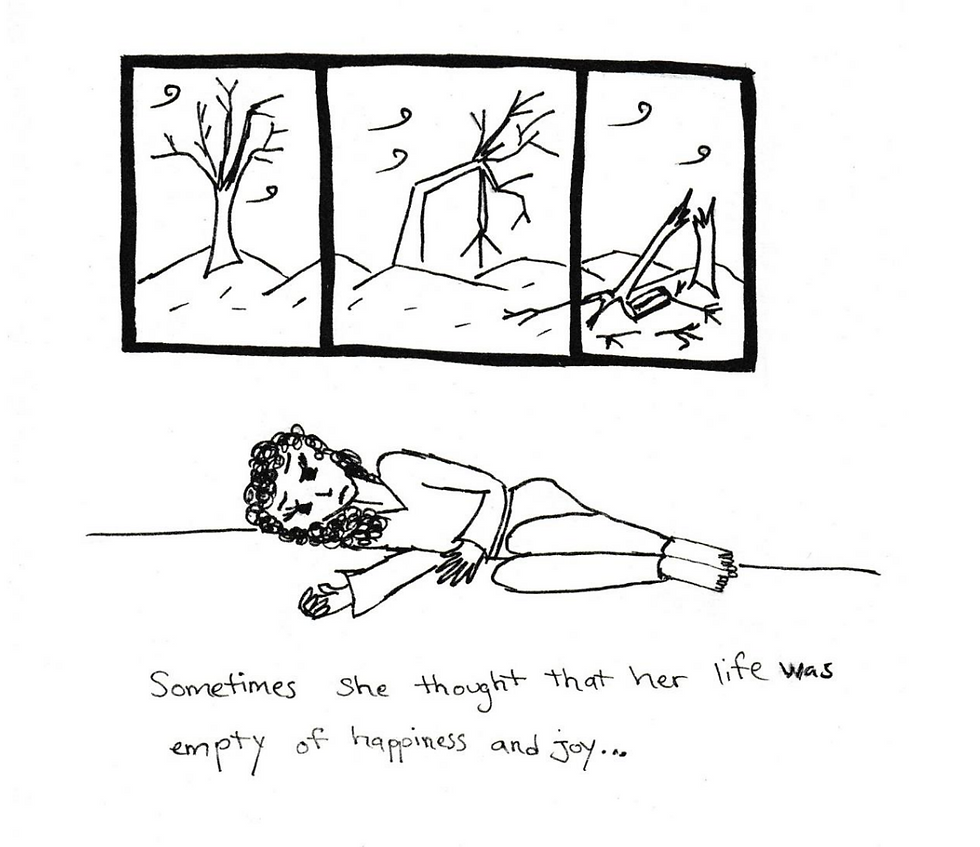
Game of Endurance
Elnaz Alikarami
Game of Endurance, is a brief narration of my observations from my good friend who suffered from a facial chronic pain. Her pain lasted for 12 years, before she finally got the right treatment and this short comic is adapted by her experiences and her difficulties of living her everyday life with this challenging medical condition, from the time the pain started until after her recovery from a risky treatment. Her life, as many other people with chronic pain, had many ups and downs, which are not easy to be recognized.
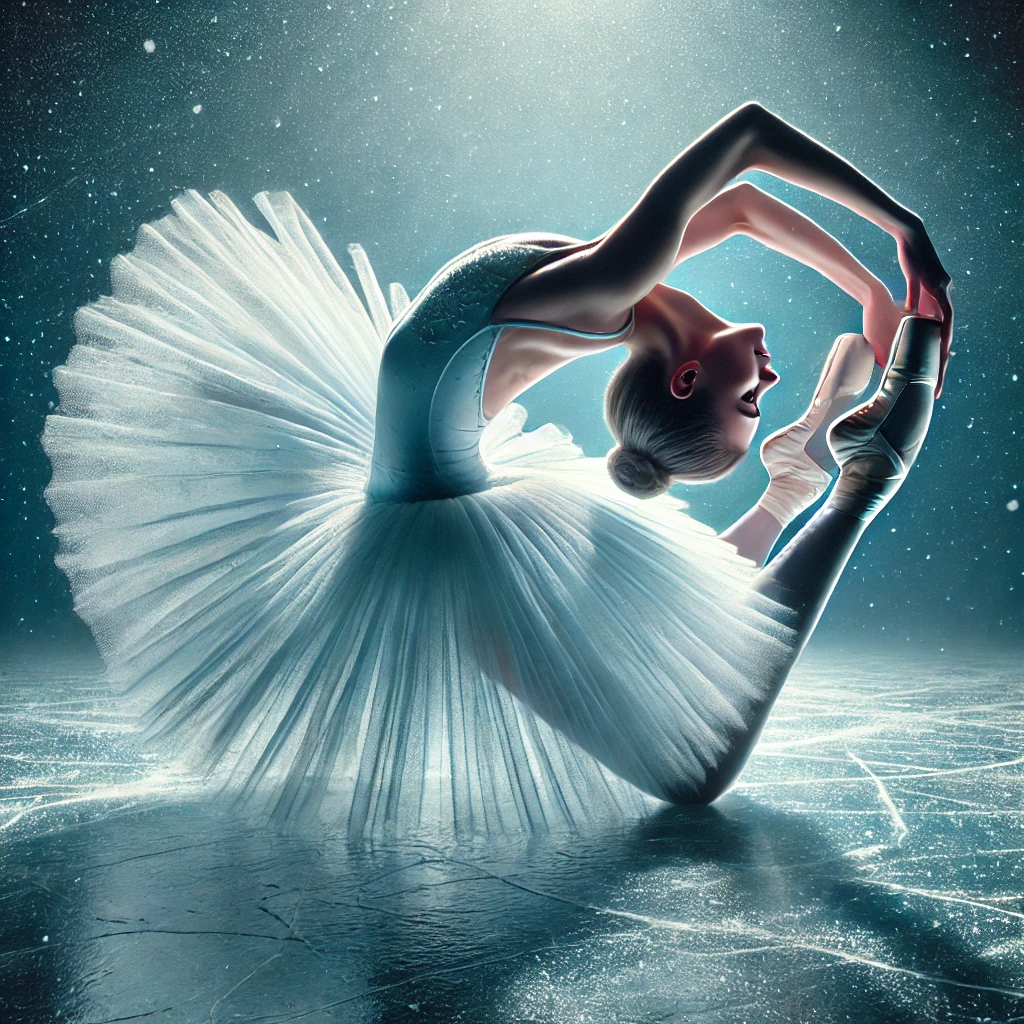
Walking on Ice
Emily Ames
Living with Ehlers-Danlos Syndrome requires strength, poise, and flexibility. This piece reflects the experience of hypermobility—where every step feels as precarious as walking on ice. Though extreme flexibility may appear graceful, it masks the reality of chronic pain and instability, creating a disconnect between how I feel and how I’m perceived.
What I do for pain remains largely invisible. Behind this image is the effort no one sees—pain management, rehabilitation, pacing, and the constant organizing of care. Every movement is calculated, every day shaped by the need to balance activity and rest. Yet, to the outside world, only the illusion of ease remains. This image captures that paradox—the beauty that hides the struggle, the unseen work behind each moment of apparent grace.

Observation is Key
Caroline Archambault
Observing the world provides a sense of serenity and connection with my environment. Capturing the details of these surroundings allows me to integrate the ordinary and the extraordinary, generating new awareness. Being introspective engenders further layers of perception and appreciation.
These are keys not only to my creativity but also to communicating and fostering a deeper understanding – for others and myself – of my lived experience with persistent pain.
.jpg)
Lady in Pain
Lizbeth Ayoub
She is one of us; a woman exposed to the invasive nature of pain. More women than men suffer from chronic pain. Chronic pain perseveres, overwhelms the body, mind and blurring one’s identity with oneself and society. Its dark web leaves one vulnerable, exposed, and subjected to its intensity. Yet, this lady stands tall, graceful in the face of adversity. Her golden head is a symbol of knowledge and future brain research for new treatments.
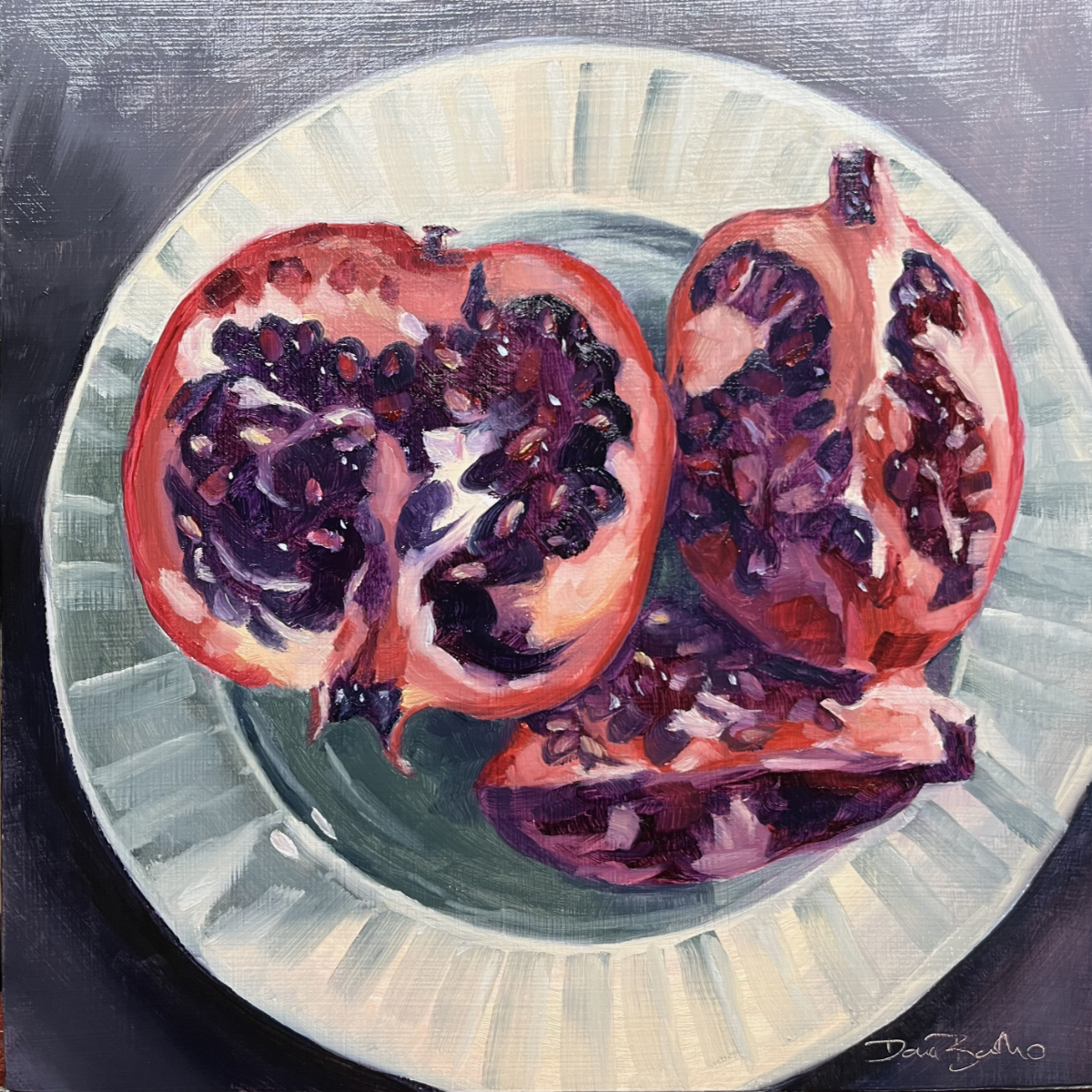
The Beauty Within
Dana Batho
A succulent pomegranate sliced open shows the beauty that is hidden within even everyday objects, and ourselves. No matter how many times it is sliced into, there is beauty to be found. Beauty is all around us, and we choose what we give our attention to. Changing our viewpoint can reveal beautiful hidden inner worlds.
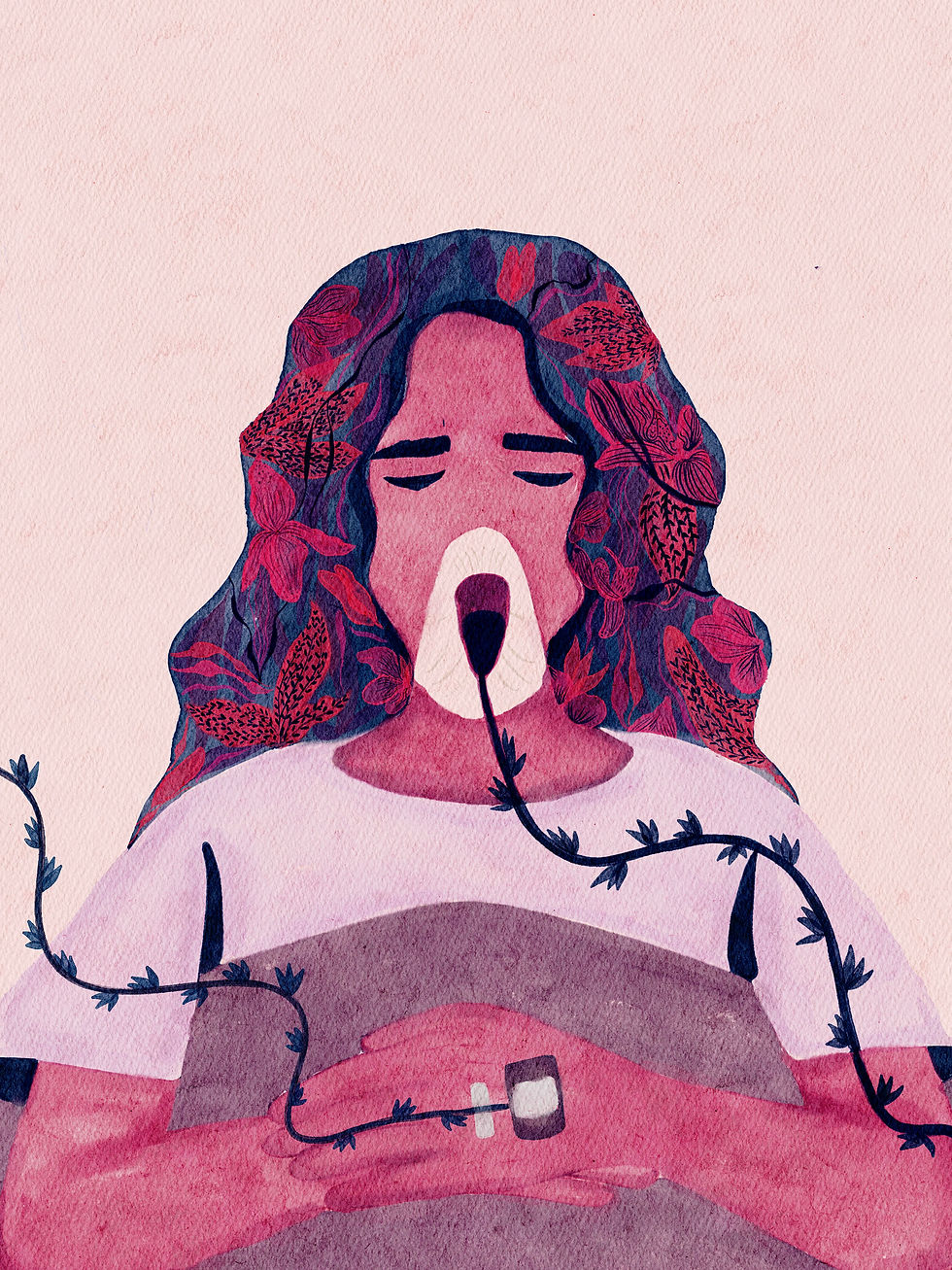
Dans Vraie Vie / In Real Life
Justine Benoit-Piau
After a touching meeting with a mother who lost one of her daughters to suicide, the choreographers were inspired by the images that emerged from her during this discussion. Through chaos and black holes, through a parallel life, the effect of grief on mental health is the main source of inspiration for the latter portion of this project.
In introduction to this dance, a presentation by Pr Pascal Tétreault was done on the personal experience of pain and the factors that influence it, which can be biological, psychological or social. He also explains how chronic pain can have a deleterious effect on mental health. Psychological pain, as one would experience when losing a loved one in a traumatic way, can activate similar brain parts as the ones that would be activated by physical pain. The use of dancers in this creation enabled the researcher to convey his words in movement, more efficiently, than with a simple PowerPoint presentation.
Each movement was specifically choreographed to portray the words of Pr Tétreault and the words of the mother who tragically lost her daughter.

Still Good
Kristina Bogdan
The painting depicts a browned and bruised banana amongst a bunch unblemished ones. The bruised banana represents the individual whose body, identity, and wellbeing has been impacted by their experiences of living with chronic pain. The unblemished bananas represent people who are close with the individual in pain, such as family and friends. The bruised banana is part of the bunch and therefore included with them if purchased. Although chronic pain is often deemed invisible to others, those living with it may feel as though they are branded as undesirable by the world around them. Despite this, the bruised banana is still good – perhaps even better -- due to its desirability as an ingredient for desserts. The ripened banana in the painting is garnished with accents of reflective, golden paint to represent the beauty and value it brings to the bunch.
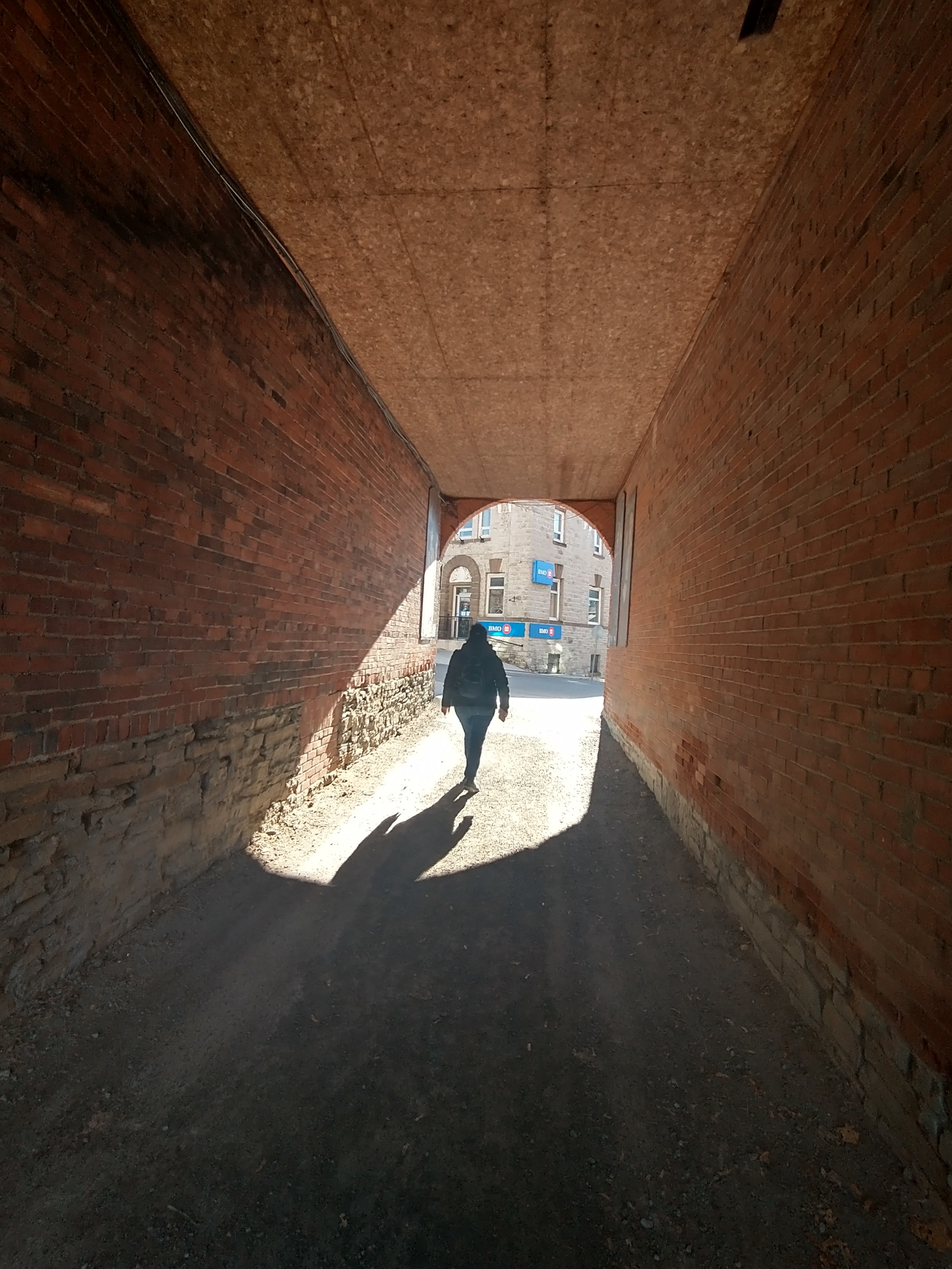
Towards the Light
Yola Boulos
It all depends on the viewers's perspective and life experiences. I see it both as the person walking towards the light from within a dark space, or from the perspective of the viewer you see others that are far ahead of you at the end of the tunnel but you still haven't traversed it yet.

Sharing in a Cup of Tea
Yvonne Brandelli
Healing hurt begins with comfort and conversation, much like sharing in a cup of tea. As easily as we can share a cup of tea, we can share knowledge to impact the lives of children living with pain and their families. Each piece of this tea set embodies the knowledge and strength of those around the table.
The teapot represents knowledge holders - with waves symbolizing the knowledge that sustains and rejuvenates diverse life forms, and the spouted vessel reflecting the flow of water to those in need. The cups represent families, designed with sprouts to symbolize different ages and stages of life. Despite this difference, both continue to benefit from the nourishment provided by water. Pediatric pain can take a physical and mental toll on families, as represented by the cracks in one of the cups. These cracks, however, have been repaired with the knowledge and support of those around the table. The repair not only allows for resumed function; it also adds an element of fortitude and growth - the epitome of resilience.
The pieces on their own are not functional – the teapot with nowhere to pour tea and the cups with nothing to fill them. These pieces are best when together, just as clinicians, researchers, and families are most effective when they work together to generate and share knowledge about pain. We are most effective when we sit together – over a cup of tea.

Between Comfort - Or
Elizabeth Cardno
Poem with subtle reference to end of life and living with chronic pain. Read the full poem here.

The Colors of the Pain Experience
Louise Castillo
Chronic pain colors many aspects of one’s life. It shades one’s work, relationships, and self-care, leading to suffering and for some, loss of employment, physical mobility, and identity.
Living with pain is emotionally stressful; some may feel trapped by their own thoughts and/or immersed in a cycle of avoidant behaviors with an aim to reduce their pain. Pain can limit a life previously known across the lifespan—an experience that can be devastatingly isolating. Yet, in the midst of that, many live through the daily peaks and pitfalls of the totality of the pain experience–experiencing a host of other emotions colored by strength and resilience in the face of adversity.

Hidden Pain
Stephanie Clark
Hidden Pain is one part of a 3-part collage series I created to explore complex feelings around living with chronic pain and my lived experience with medical professionals. Using my own photographs printed in colour and black and white, the rocky terrain shows the general environment of dealing with pain as hard to navigate. Using the combination of imaged in colour and black and white is meant to illustrate what we can see with pain (colour) and what is hidden (black and white). The very nature of collage allows for the layering of images and to decide how much is shown and leaves the viewer wondering what is layered underneath. The words selected show the dichotomy of what we are led to believe about medicine and the expectation of help vs. my personal experience of finding no help and having my pain dismissed.

Never Eating Sushi From a Vending Machine
Rebecca Clifford
Pain comes to us at different times, in different ways, and all of us handle it differently. Arthritis has limited what I can manage in my life; but I recall other pains, such as searing cramps during my monthly cycles accompanied by blinding migraines; and pains incurred by bad choices - a pair of sexy heels that threw my back out for three months, or vending machine food. Often you want to cry; sometimes you just have to laugh. Me, I use words to express both pain and pleasure.

In the Silence, I Still Hear Your Voice
Ella Crompton
Sometimes I wonder what would’ve happened that night, if I called for you and you didn’t answer.
If sleep had kept you under its weight and my voice didn’t slip through the cracks.
If the tears that cascaded down my face didn’t worry you, if my words didn’t frighten you.
I wonder what I would’ve done.
But I also wonder what it was like for you.
For you to hear my voice slip through the cracks, breaking with every word.
For you to see my tears as they poured down my cheeks.
I wonder how scared you felt.
What I never wonder though, is why, when I sit in silence, I hear your voice.
When I speak into nothingness, with no response, your voice echoes around my head.
I never wonder, I never will, even when I thought I lost everything;
I never lost you.

Prends ton temps
Gabrielle Desjardins
La douleur s’apprivoise lentement et il faut lui donner de l’amour comme à une plante. Un jour, on peut voir la floraison de nos efforts. Mais attention, trop lui donner peut être tout aussi néfaste que de ne pas lui en donner suffisamment. Trouver le juste milieu est le défi de toute une vie.

Silent No More - Silence Rompu
Amy Doucet
My journey and voice in pain research - Mon expérience enfin entendue

Garden of Pain
Melody Dover
Among the thorns hope may bloom. As someone living with Chronic Pain for almost 8 years, the incessant tangle of fighting, managing and coping with pain that invades all facets of my life, but I lean into hope that support from my health professionals, love from family and friends can help me to cope with the hardest days.

Lookin’ Good
Levi Du
Those moments when you can see a glimpse of yourself in a good light despite the pain. The space between believing that you deserve to take care of yourself… the evidence that its ok to be you.

Embrace: Maybe not a cure, but definitely help.
Veronica Dudarev
Persistent pain is a lot of things, and what is often overlooked in this boatload is that persistent pain is isolating. It limits, sometimes severely, one’s participation in life and social relationships. While persistent pain usually exposes one to a lot of medical attention, it also drives one’s friends away. Many people with chronic pain find that there are fewer people whom they can still call friends. For many people, persistent pain causes conflicts within the family and sometimes leads to a divorce.
Indeed, it is challenging to be in a relationship with a person with chronic pain. Why it is so is a good question, and maybe a complex issue that involves both our natural desire to form relationships with successful people, our tendency to avoid frustrations (and pain is very frustrating in oneself and others), and probably a bit of empathy too. It is painful to look at someone in pain, and research shows that seeing someone in pain activates the same network in the brain that is involved in experiencing pain. Whatever the forces are, the result is that loneliness is a huge issue for people with persistent pain.
And it exacerbates pain. It likely does, research suggests. To be more precise, presence and support of other people alleviates pain. This is why I gave this ink painting this title: Embrace, maybe not a cure, but definitely help. Being kind and patient with people is not such a bad idea in general, and we humans may need reminders about that all the time (myself included). For people with persistent pain this is even more true. There is a lot of frustration in and around them, a lot of pain, which is unpleasant inside and outside. Yet one simple way to help is to simply be there.

Storm-Trapped Dreams
Nashmil Ehsaei
Hi, I'm Nashmil, and I have a story shrouded in darkness. Once, I thrived as a successful graphic designer, with a multitude of advertising clients and orders. I reveled in the art of playing with colors, shapes, typography, and layout... until an unforeseen tempest struck. In an instant, my radiant world was engulfed in darkness, plagued by double vision and relentless dizziness. The vibrant hues I once cherished had faded away. A diagnosis followed, revealing a rare autoimmune disease affecting my eyelid, casting a shadow over my entire existence. The only thing I could hold onto was my smile... I hoped it was fleeting. Even the longest night will end, and the sun will rise. So I smile.

The Path to Healing
Ezinne Ekediegwu
A poignant narrative that delves into the multifaceted journey of managing and overcoming pain through physiotherapy. The story begins with the protagonist stepping into a clinic, a sanctuary of hope and healing, seeking relief from their persistent pain. This piece vividly captures the physical and emotional challenges faced by the patient, offering a comprehensive exploration of the theme "What do I do for pain?"
Through detailed descriptions of the physiotherapy sessions, the narrative illustrates the various techniques employed to address pain, from gentle massages to intense joint mobilizations. Each session is a testament to the patient's resilience and determination as they push through discomfort and frustration to find solace and recovery.

Planting Seeds in the Wind
Ezinne Ekediegwu
Within this evocative artwork lies a profound narrative that encapsulates the enduring struggle of a patient suffering from endometriosis, whose existence is characterized by persistent pain and weakness. Through her poignant portrayal, the artist conveys the individual's unwavering commitment to raising awareness and fostering understanding of this debilitating disease within her challenging societal context.
The central figure, adorned in traditional Nigerian attire, serves as a poignant representation of the broader societal challenges faced by individuals grappling with endometriosis in Nigeria. The deep crimson hue of her garments symbolizes the profound suffering endured and perpetuated by the disease. With a hand firmly clasped to her abdomen, the locus of her anguish, she endeavours to scatter seeds into the wind. These seeds serve as potent symbols of her tireless efforts to sow awareness and enlightenment regarding her condition. Yet, the wind itself serves as a metaphor for the societal currents that buffet her efforts, for the prevailing ignorance and indifference that shroud endometriosis within her community.
Indeed, statistics reveal a staggering reality: one in ten women are afflicted by endometriosis, yet awareness remains alarmingly scarce. In Nigeria, the dearth of specialized medical practitioners exacerbates the plight, with no more than two Endometriosis specialists navigating the complex terrain of this condition. Globally, the paucity of knowledge and the absence of a definitive cure cast a shadow over the lives of countless individuals.
The tragic narrative continues with accounts of medical practitioners dismissing patients' symptoms as imaginary, prescribing ineffective treatments, and even subjecting sufferers to ridicule and mockery. Consequently, delayed diagnoses and preventable tragedies ensue, perpetuating a cycle of suffering and despair.
Yet, amidst the darkness, a beacon of hope emerges. Through her resolute advocacy and unwavering determination, the protagonist endeavours to illuminate the shadows shrouding endometriosis. Her indomitable spirit serves as a rallying cry, compelling society to confront its collective ignorance and apathy. Thus, through her courageous crusade, she endeavours to sow the seeds of awareness and understanding, nurturing a brighter future for generations to come.
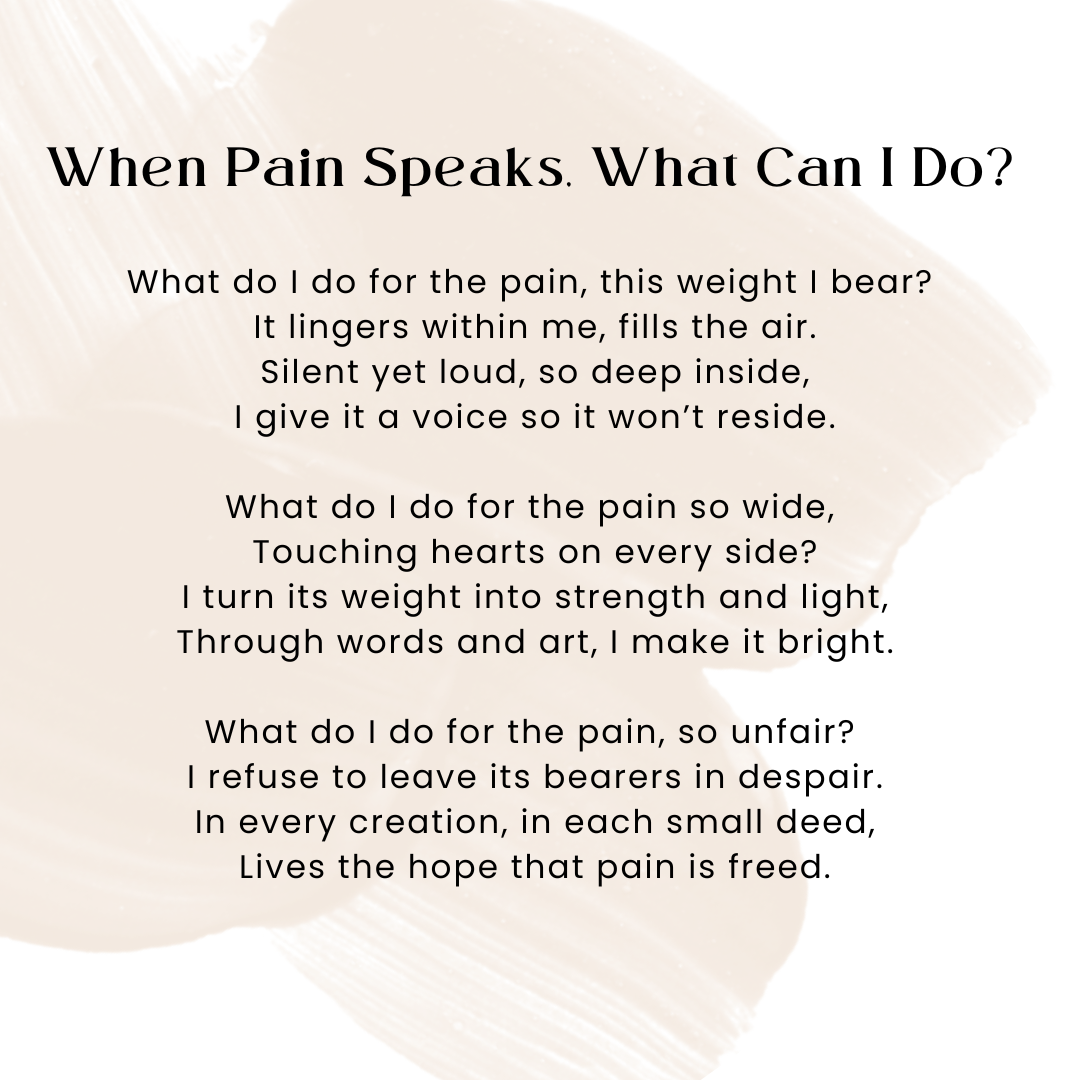
When Pain Speaks, What Can I Do?
Nataly Espinoza Suarez
Read the full poem here.(https://static.wixstatic.com/media/21223c_f36dde1980444af59de9e0d852dcd4e6~mv2.png)
This poem explores the deep and persistent nature of pain, both personal and collective. It reflects on how pain exists within us—intimate, overwhelming, and often unheard. The poem emphasizes the power of creativity and empathy in addressing pain, not just for oneself but for others who endure it in silence. It conveys a message of resilience, hope, and the importance of acknowledging and understanding pain to inspire change and healing in the world.
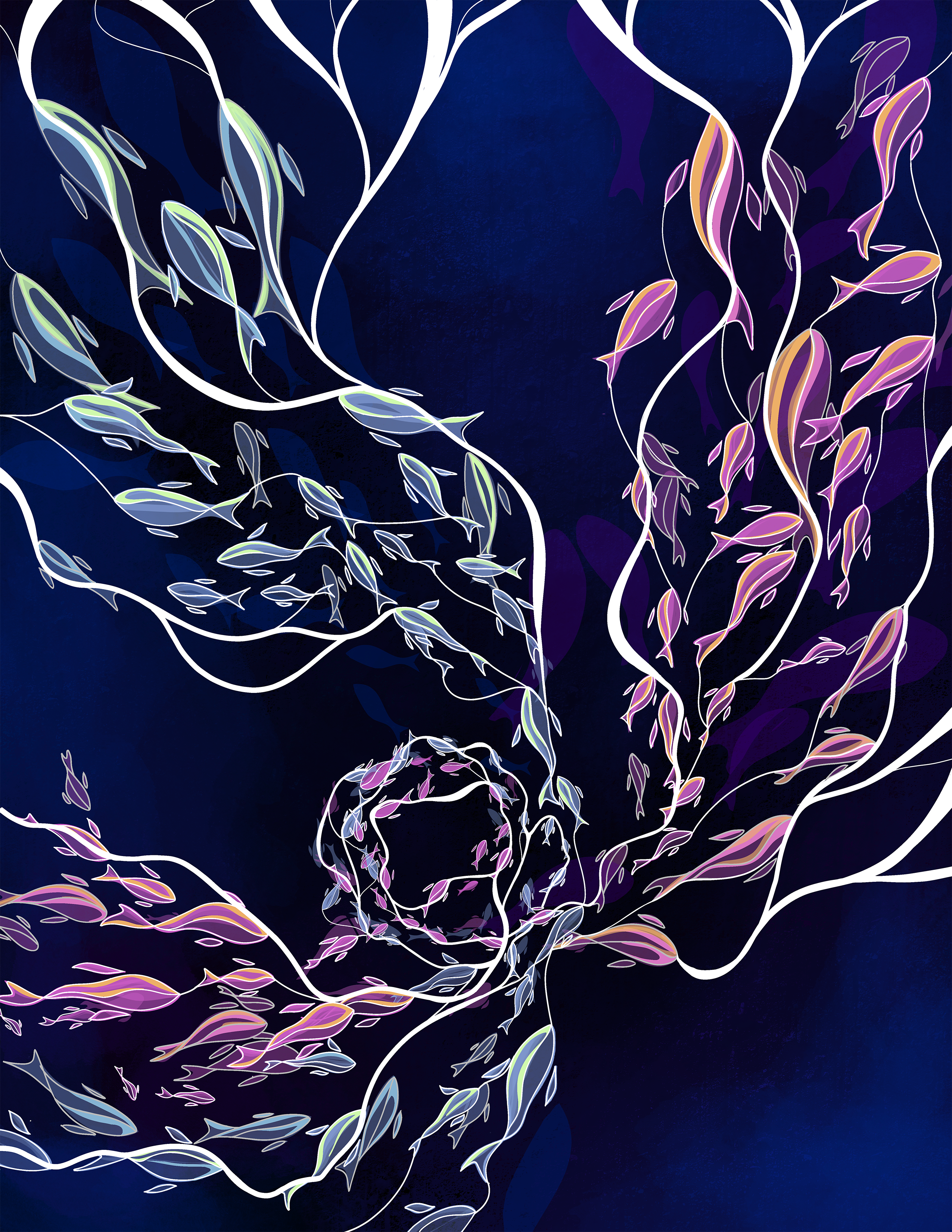
Convergence and Divergence
Churmy Fan
This design was inspired by the theme of converging and diverging mechanisms in pain pathways. The motif of two schools of fish swimming through a stream, swirling together then apart, illustrates the idea that pain mechanisms are more complex than black and white, and rarely stay a straight course. At various levels, mechanisms can converge, diverge, and interact with each other, like these schools of fish. This illustration highlights the beauty and complexity of cellular and molecular pathways.

Sewn in Strength
Caitlin Fast
Embroidered Female Endo Reproductive System Anatomy

Shine in the Darkness
Lauren Ferreira
"Shine in the Darkness" depicts a heart surrounded by darkness, with arteries morphing into candles. One of the candles has burnt out – as the others eventually will, too – but, for now, the remaining ones shine; perhaps not as brightly as they could've shone had life been different, but as brightly as they can under the circumstances.
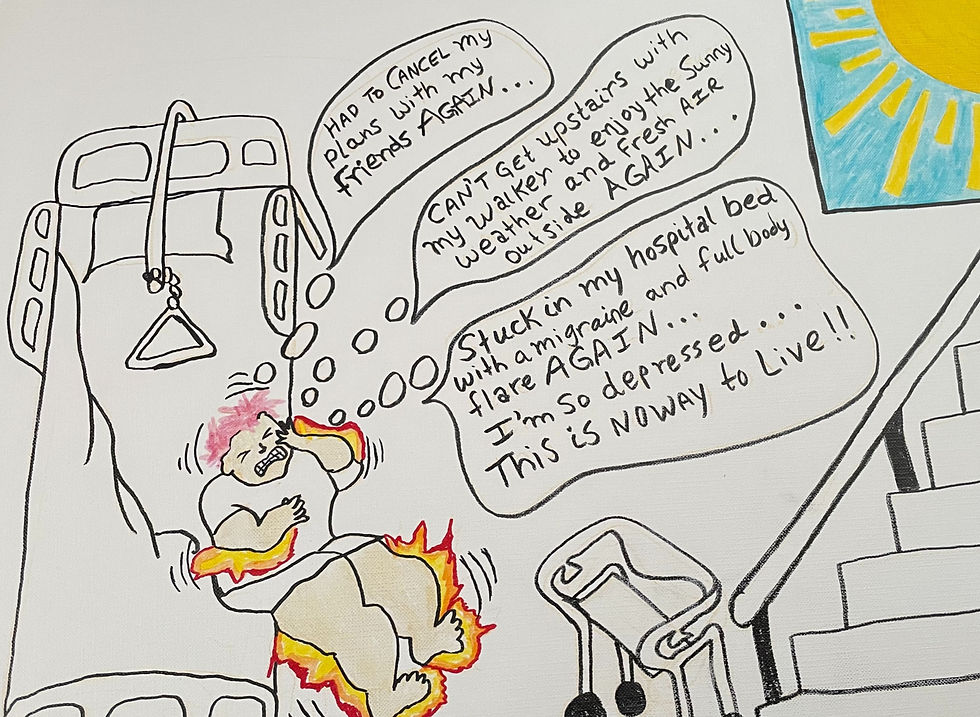
Unrelenting Pain and Suffering
Dayna Fesciuc
This Artwork clearly depicts the 24/7 pain, feeling of isolation, trapped inside experiences I have daily from CRPS, Fibromyalgia, Migraines and Depression.

Path to the Zombie's Studio
Reilly Fitzgerald
This is literally a painting of my shed/studio, where I have lived and created for over a decade, to shelter my family from my constant suffering. I chose a winter scene because, like winter, chronic pain is a form of death, where most aspects of living, important to one’s identity, are taken away; we become the living dead. A hint of this zombie appears in the studio window.
The path symbolises the difficulty of trudging through the snow-covered landscape of a life with pain.
Obscured and blocked by trees, branches, and the studio, the line joining earth and sky, important to the theme of “Shared Horizons” demonstrates that although we see the same horizon, one’s perspective may be obstructed. The scene is almost monochromatic and shadows cover most of the landscape, in an absence of variation, colour, and vitality, like a life drained by constant suffering. However, luminosity and occasional swaths of bright yellow symbolize hope on the horizon and throughout the landscape.
Possibly the most important feature of this creation isn’t obvious to the removed viewer. Like the pain that commands one’s body and similar to viewing a horizon from different perspectives, the things obstructing one person aren’t noticeable to others. This art which appears to be like any other painting, is warped. I stretched the canvas on a repurposed picture frame, usually decorative but now structural, and it twisted. The warped canvas, which I normally would discard, is utilised as a symbol for the hidden ailment of chronic pain.
To survive living with constant pain one has rethink what is available, like finding a purpose for my warped canvas, or on a larger scale, my personal ability to still paint and create so that I have a therapeutic release, a purpose, and a contribution to society.

Displacement
Chloe Fleisher
I am a 13-year girl who has lived with chronic pain for more than 5 years. I drew this image to express how I sometimes feel when I'm in pain -like I am drowning or submerged. The pain consumes my whole body. I am helpless and there is nothing I can do to stop the suffering or to help myself.
Note: The art work was submitted by the parent of a child with chronic pain and medical complexity. The author of the art submission is her 13 year old daughter Chloe Fleisher

The Agony of Burning Pain
Stevie-Stefano Foglia
This painting is painted in oils on a linen canvas. It depicts a silhouette of a woman hunched over with her hand on her face in agony of the burning pain she is feeling represented by the flames coming off of her.
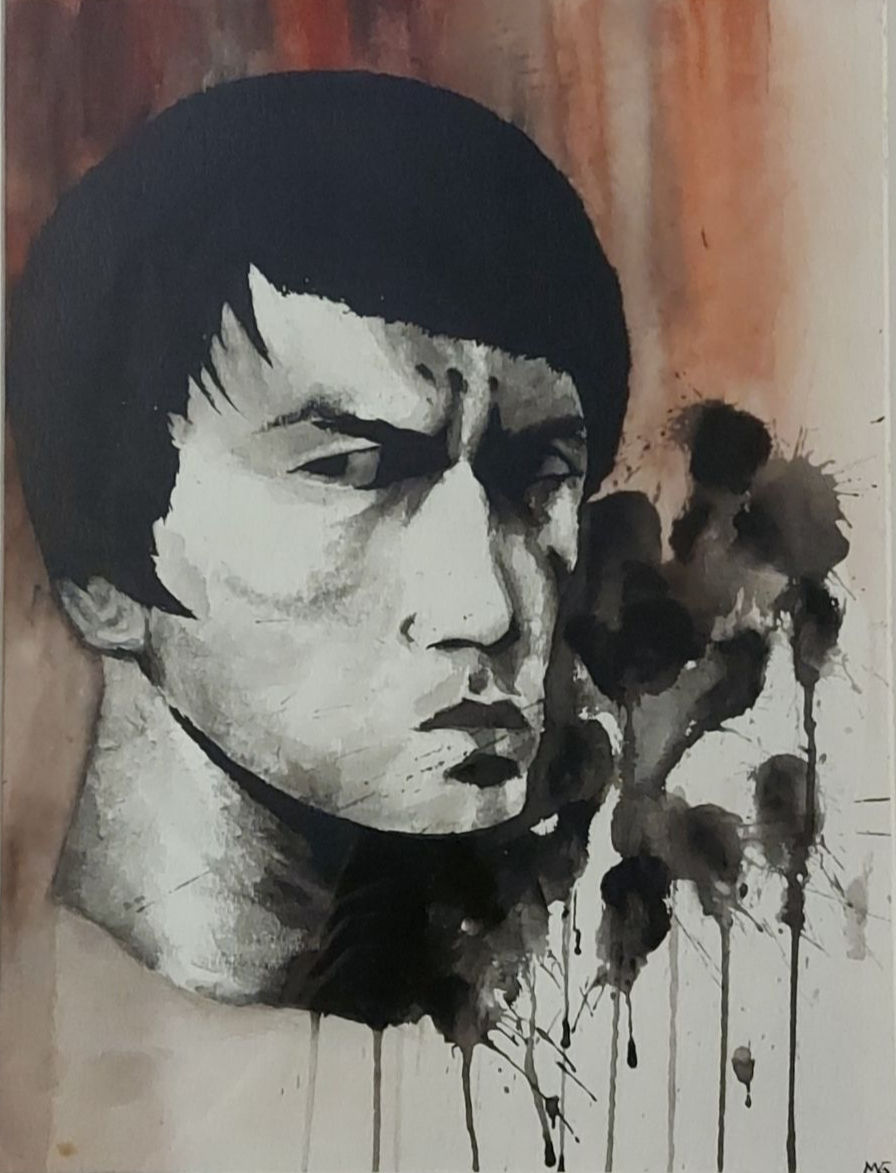
Never give up hope
Mael Gagnon Mailhot
The painting was done after I lost the ability to do everything I loved due to chronic pain. It was the first thing I created once I started to learn how to live with chronic pain.

Pain Over Powers
Eglee Gimon
Pain is a particularly unpleasant sensation, a way in which our body alerts us of physical threat or injury; its effects frequently go beyond physical and could significantly impact our core mental and psychosocial wellbeing. On the other hand, psychosocial and spiritual elements of our lives could magnify the expression of pain; total pain is the term coined by Dr. C Saunders used to describe such situations.
The young lady in this picture confronted not only the reality of a recent pancreatic cancer diagnosis but the unfortunate complication of surgical treatment leaving a nonhealing fistula and its life-changing consequences (including indefinite dependency on total parenteral nutrition). She embodied total pain/extreme suffering and frequently commented on how she felt death was always peering over her shoulder; a black rose tattooed in her left forearm represented her hope for transcendent healing. The involvement of a compassionate, caring and cohesive multidisciplinary team (including multiple physician disciplines, nurses, dietitians, psychologists, social workers, occupational and physical therapists, spiritual care practitioners) was essential to optimally address her pain management.
This illustrates the importance of a holistic approach to pain assessment and management.

Pain and the Circle of Life
Eglee Gimon
Pain alerts us of something wrong with our physical being, and its expression can be magnified or diminished by circumstances in our personal/ social/ spiritual life. Throughout our life we are exposed to circumstances that may lead us to experience pain and pain may also influence the way we interact with others around us. Furthermore, throughout our life we are influenced by the roles played by people in our lives, and we ourselves play roles that change our experience of pain.
This picture depicts the circle of life, the person is going through the stages of life, influenced by different roles of others in ones life and also by also playing roles oneself within the societal sphere . The roles are depicted by hats, the ones worn/played by the person are shadowed in yellow, the roles played by others are not shadowed in yellow but do influence the person’s life by setting limits, creating stressors or providing coping mechanisms.

Pain Strikes
Eglee Gimon
Like a lightning bolt that comes from nowhere pain paralyzes you and breaks you inside and out. Shattered, you can barely stand in the midst of this thunderstorm; everything around you looks densely gloomy... it is hard to see a way out.

Stressors and Saviours
Lisa Kimberly Glickman
"Stressors and Saviours" is a symbolic portrayal of the intricate dance between anguish and solace, manifesting in a surrealistic image that mirrors the artist's inner turmoil and resilience. The canvas is a tapestry of contrasting elements.
On the left, the stressors emerge, looming ominously like dark clouds on the horizon. A spectral image of financial burdens casts a shadow, its tendrils reaching out like gnarled roots, ensnaring the mind in worry. Nearby, a swarm of carpenter ants and earwigs scuttle in chaotic patterns, representing the relentless intrusion of anxieties real and imagined, their presence magnified by the fear of impending collapse. Flames lick at the edges, a visual manifestation of the ever-present dread of house fires, their flickering tongues threatening to consume all in their path. Amidst this turmoil, the artist's twin daughters are depicted by their vulnerable state as they struggle with Celiac and Crohn's diseases. The artist’s shoulders bleed: this is the source, coming through her nerves in the back: acute brachial neuritis.
Contrasting this, the saviours emerge as beacons of hope. Things that bring the artist joy: animals, nature, children, reading, art-making. Offering solace. Lotus flowers represent the possibility of re-birth.
Through "Stressors and Saviours," the artist invites viewers to embark on a journey of introspection, navigating the turbulent seas of adversity while clinging steadfastly to the life rafts of joy and resilience. It is a poignant reminder that amidst life's storms, there is always beauty to be found, and strength to be drawn from the depths of the human spirit.
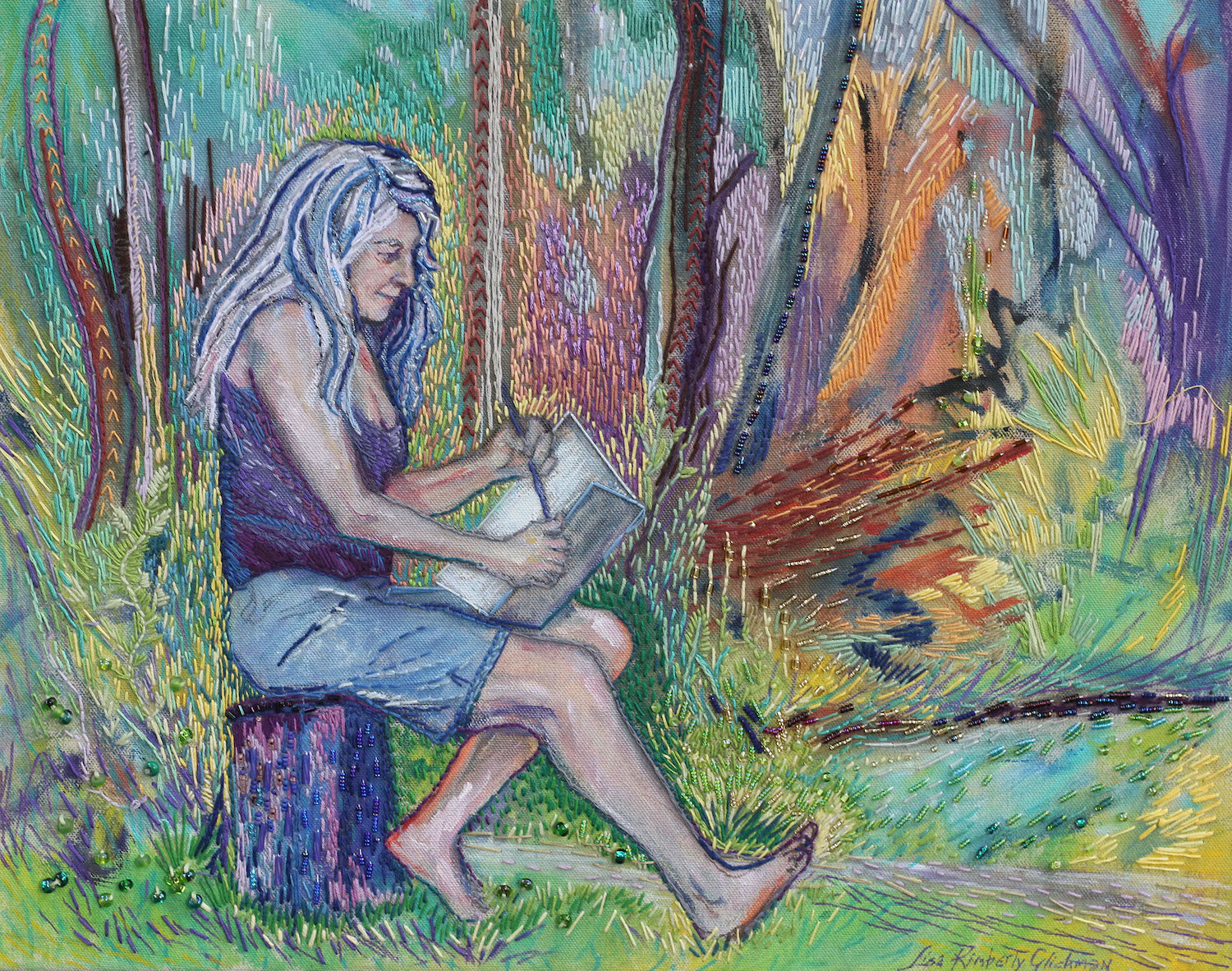
Sketching in the Garden
Lisa Kimberly Glickman
This self-portrait captures me sketching in the garden—my sanctuary—surrounded by nature on a warm, sunny day. I’m barefoot, as I love to be, fully immersed in the creative process. When my brachial neuritis flares, even holding a drawing tool can become impossible. Yet, when I can, I adapt—sometimes drawing with my non-dominant hand—because creating is essential to me. Art is my ultimate refuge from pain; as I lose myself in color, composition, and expression, the act of making overrides the relentless signals of neuropathy and neuralgia. In those moments, creativity becomes not just an escape, but a way to reclaim a sense of control and relief.

Pain Chronification: A Psychoeducational Song Bridging Science, Emotion, and Recovery
Pavel Goldstein
Based on the music of Californication by the Red Hot Chili Peppers, conveys key insights about chronic pain, its psychological and neurological underpinnings, and its societal impact. The song’s narrative explores themes such as fear, catastrophization, and reliance on biomedical treatments while emphasizing self-empowerment, emotional regulation, and the role of neuroplasticity in recovery. The familiar melody ensures recognition and emotional connection, while the new lyrics deliver an educational and relatable message.
This song was written as a personal reflection following a car accident, which catalyzed an understanding of pain mechanisms and the mindset required for recovery. It combines a scientific perspective with a hopeful message, demonstrating how personal experience can inspire others. The performance is brought to life by a young band of university students living in dormitories, with members from diverse ethnic backgrounds, including Russia, Ukraine, and Mongolia.

Born Too Soon
Haleh Hashemi
Approximately 1 in 12 Canadian children are born prematurely, often requiring extended stays in Neonatal Intensive Care Units (NICUs). These early beginnings can have profound impacts on their physical, cognitive, and emotional development. Very and extremely preterm infants endure more painful procedures and longer hospital stays compared to full-term babies. In 2023, the World Health Organization (WHO) emphasized the importance of at least 8 hours of daily skin-to-skin contact for preterm infants, highlighting benefits such as reduced neonatal mortality, enhanced brain development, and improved parental mental health. However, the fragility of very preterm infants and their reliance on medical devices like ventilators and feeding tubes create significant barriers to providing this essential care. These challenges add to parental stress and complicate distress regulation for infants. This artwork reflects the delicate balance of hope and struggle in caring for preterm infants, honouring their resilience and the strength of their families.

Through the Ripples We Heal
Joshua Hazan Mea
Through the imagery of a mother swan guiding her three cygnets across a calm yet rippling lake, this watercolour piece attempts to capture a patient's journey of finding relief from pain. The flowing watercolours represent how pain ebbs and flows, affecting both body and mind. The mother swan symbolizes strength, leading her young through uncertain waters, much like how people facing pain rely on support and connection to navigate their challenges. The ripples around them show how pain doesn’t just affect one person—it impacts families, caregivers, and communities. Each colour in the piece tells part of a patient's story: deep blues for moments of despair, warm yellows for sparks of hope, and soft greys for moments of reflection. Inspired by the theme "Shared Horizons: What do I do for pain?" this artwork highlights the importance of care, resilience, and the strength we find in each other when facing life’s struggles.

Through Art and Sound: A Social Journey in the Experience of Pain
Laura Hernandez
Content warning: Flashing lights.
People with chronic pain may have limited social lives, experiencing sadness, otherness, and even feeling like their pain is not believed. Pain-related disability can affect those caring for people with pain, eliciting feelings of stress. Still, high-quality relationships might positively affect individuals with pain, and pain validation could help them cope. These complex relationships between pain and social life inspired our digital mixed media sculpture.
First, images projected onto the brain figure portray sensations of pain, accompanied by emotions of hurt and isolation. The sharp sound of pain and its distortion allude to pain intensity and feeling pain itself.
Then, enriching, healthy relationships co-occur despite the pain. Taken from Erik Satie’s Gymnopédie No. 1, the music depicts a conversation between pain (the resonant violin) and one’s social network (voice) to mirror how social life intersperses the experiences of those with pain. As the song progresses, the note symbolizing pain is constantly present; however, the final chord sings the harmony that supportive, high-quality relationships may bring, as family and friends journey with individuals with chronic pain.
Conceptualization and sculpture: Laura Hernández, William Forero, Mica Marbil
Visuals: Laura Hernández, William Forero
Audio: Laura Hernández, Mica Marbil

Unseen Struggles, Shared Horizons
Rangana Hetti Arachchige
“Unseen Struggles, Shared Horizons” is a visual journey through the hidden realities of chronic pain in Canada. From the relentless toll on trades workers to young adults lost in the transition between care systems, from aging bodies bearing decades of discomfort to the silent suffering of those without stable housing—pain is everywhere, yet too often ignored. Each image captures a moment of endurance, isolation, and resilience, reflecting the systemic gaps that leave many without adequate support. But pain is not just an individual experience; it is a shared reality that demands collective action. This collection invites viewers to see beyond the surface, to recognize the humanity in suffering, and to imagine a future where pain care is equitable and accessible for all. Through these images, I ask: What do we do for pain? And more importantly, what can we do together?

Walking Through Stone: A Life with Chronic Pain.
Richard Hovey
Imagining (my) pain if one picture could sum-up my research about the life changing disruptive force of chronic pain this one comes close. Living with pain incarcerates the person weighed down by pain. A burden carried with them every second, minute of every day for life. My applied hermeneutic research delves deeply into the meaning of living with chronic pain and related suffering. Loss of jobs, physical mobility, concentration, personal relationships can often lead to a traumatic loss of identity, the briefcase representing the fading memory of self. Pain isolates people from society, friends and family with damaging repercussions. My research coupled with my own lived experiences of pain endeavours to understand the totality of the chronic pain experience and use this information to build more comprehensive opportunities for people living with pain such as help re-building positive identities and reduce social isolation. A metaphorical chipping away of stone.
The picture was taken by Richard Hovey (2017) of the Monument to the Unknown Bureaucrat Reykjavik, Iceland sculpted by Magnús Tómasson in 1994.
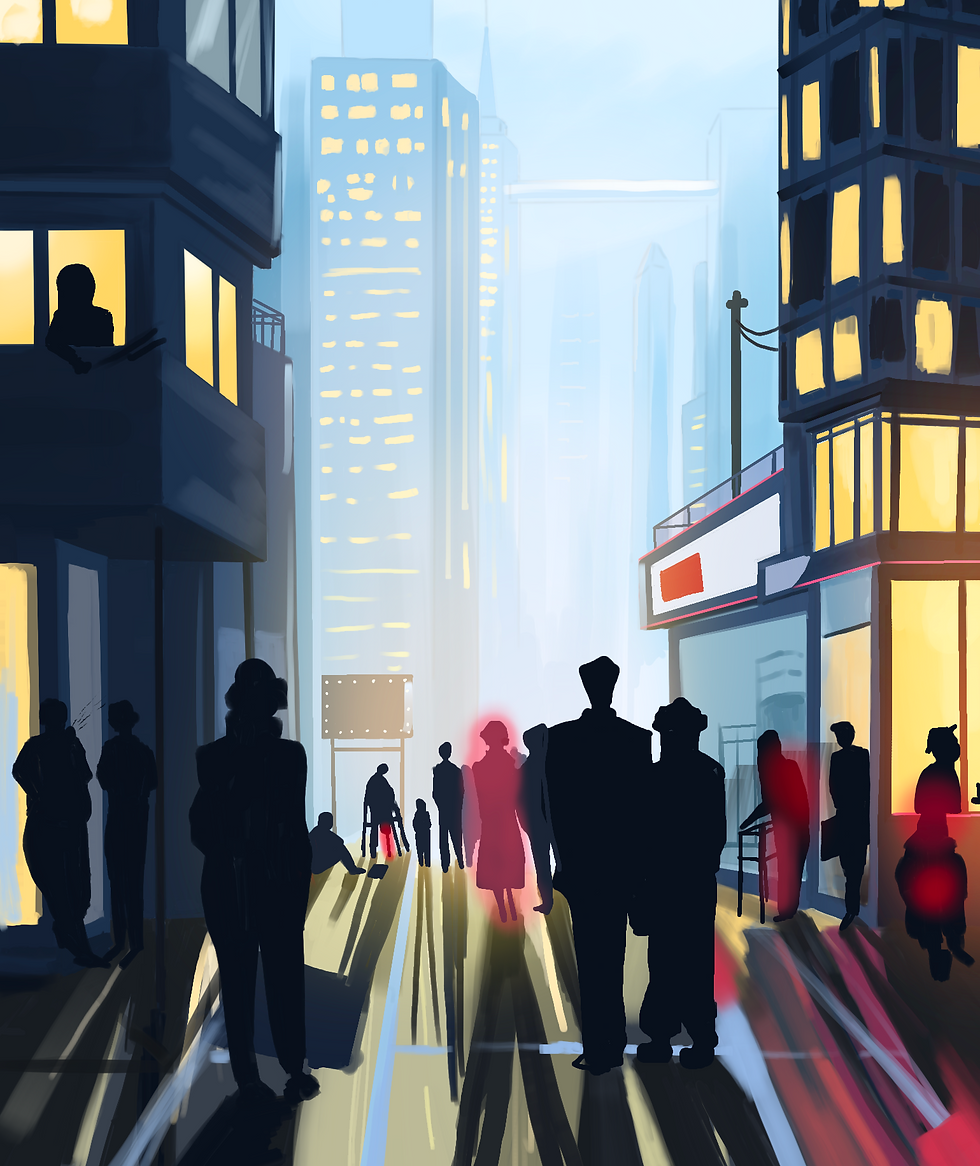
City of Hidden Stories
Yu Tong Huang
My piece aims to visually portray multiple facets of the modern society for people living with chronic pain, who make up about 1/5th of the Canadian population. While chronic pain, and its resulting functional, social, and psychological burdens, weigh heavily on every aspect, every second, of their daily lives, it is often difficult to discern, when strolling in the city, those suffering from it. This is amplified by the isolation and facade many adopt to avoid judgement for being "dramatic" or "drug-seeking". The red hues represent the people living various chronic pain conditions, hidden within the crowd. This piece makes an attempt to represent certain groups, such as women, veterans, and elderly people, that are disproportionately affected by chronic pain conditions. Only with collective, multifaceted progress in areas such as education. stigma. healthcare, and research can our society hope to improve their quality of life and walk toward a brighter horizon.

The Monarch's Garden
Jonathan Isenor
"The Monarch's Garden" is a testament to resilience, where beauty flourishes. Two monarch butterflies, symbols of transformation and hope, grace a vibrant sunflower patch. The stained-glass-inspired background, with its intricate patterns and luminous colors, reflects the complex layers of lived experience, both the fragility and the enduring strength. This painting explores the power of art to transcend physical limitations, capturing the enduring strength of the human spirit to find joy and beauty in the world around us.

Depicting Orofacial Pain From Patients' Perspective
Sripriya Jayaraman
This is a picture of a patient in profound agony from chronic orofacial pain. One side is the physical aspect, where pain is variously described as electric shock like, stabbing, throbbing and sharp. On the other side is the psychological aspects that fuel pain - trauma, PTSD, incarceration, natural disasters and so on. This debilitating pain is experienced even though it’s a wonderful day filled with warm sunshine, good food and loved ones. But patients are in such excruciating pain they cannot enjoy themselves.
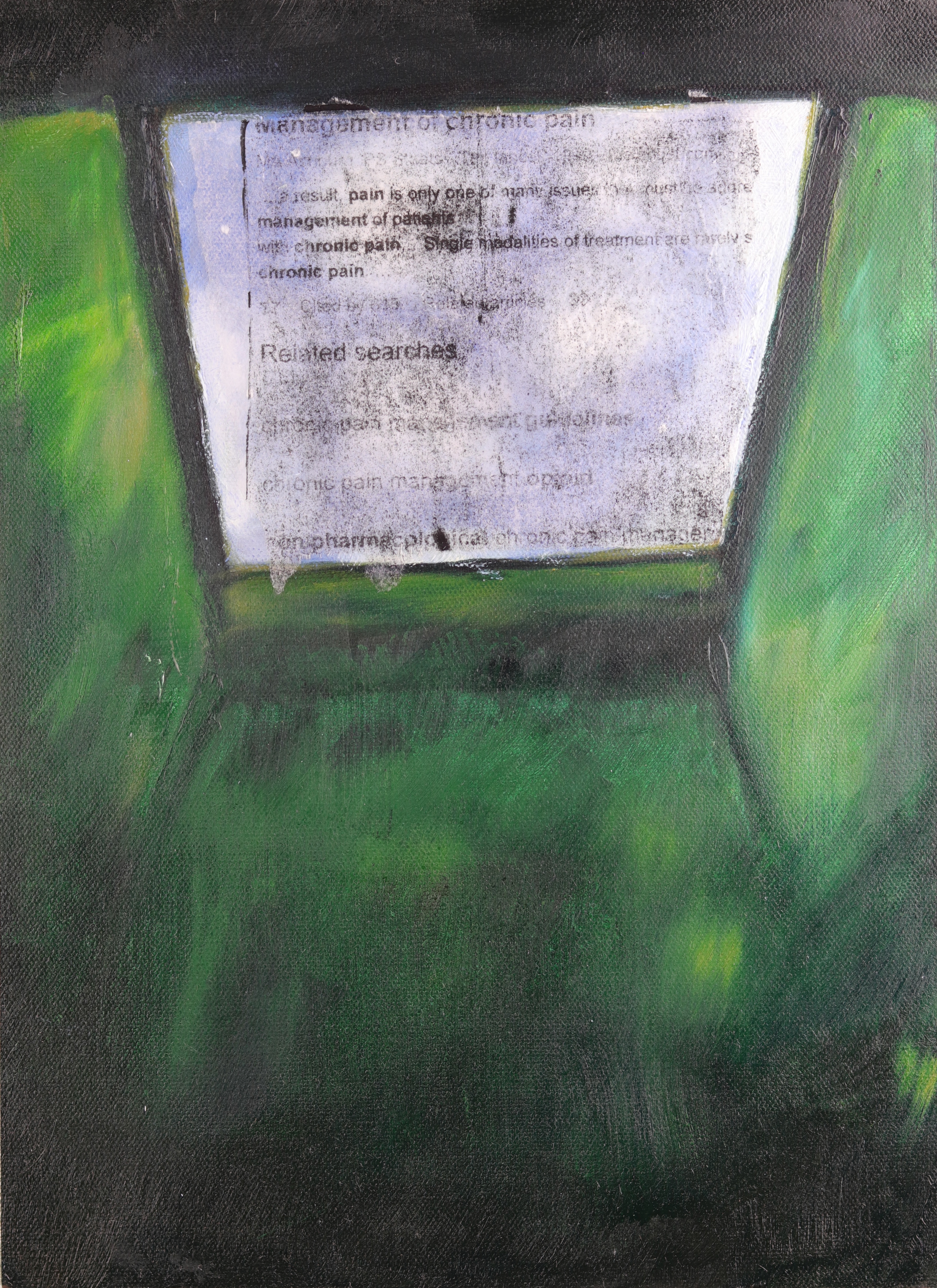
2am Painsomnia
Isabel Jordan
It’s 2am. I’m in pain, or maybe one of my kids is in pain. Either way – it’s painsomnia. Laying on the bathroom floor, hoping the flare will pass, I stare out the skylight and rail against the universe for torturing us like this. I breathe. I breathe more slowly. There’s no point in going to bed. Instead, I search again… looking for answers… looking for help… looking for options that we didn’t know were possible. I breathe. It won’t help this flare, but maybe it will point us to a direction that can provide relief. Until then, I breathe in for 5, hold for 5, and breathe out for 7. And I keep searching.

Blooms on Neural Threads
Monika Kataria
This artwork represents the shared journey of people living with chronic pain and the caregivers, researchers, and clinicians who support them. The vibrant blooming flowers symbolize resilience and growth, while the small human figures seated within the petals capture deeply human moments of introspection and vulnerability experienced by people living with pain. The delicate neuron threads interwoven throughout highlight the vital role of researchers and medical professionals, whose efforts provide understanding, connection, and hope to those navigating pain. These threads nurture the blooms, reflecting the collective compassion and empathy that drives healing and progress. This piece celebrates the strength and humanity of those impacted by pain and the enduring power of unity.

The Green Pacifier (an email to a physiatrist)
Ben Kates
Stream of consciousness introspection.

Many Hands Make Light Work
Samantha Kelly
This piece speaks to the hope for more team-based care in our health care system. In my journey with chronic pain, I have been carved into pieces by every medical and health professional I sought care from, particularly in those systems that limit your visit to a single inquiry for the allotted minutes of care.
Having to choose which parts of me got attention and which had to wait created this constant tug of war in my mind, forcing me to have to decide which parts felt the worst and deserved attention. When in reality, every piece of me needed to be assessed. And the most important part, the one that was never inquired about, but that required the most attention of all, was my mind.
Since finally acknowledging all of the pieces of me and advocating for whole-self care, I feel hope once more that I may find relief, or at least, acceptance, of a life with pain. The many hands in this piece are all of the practitioners from physical therapists, medical doctors, holistic healers, to trauma counsellors that have helped in my efforts to put the pieces of me back together.
I intentionally kept the piece as a black and white sketch to illustrate the simplicity of the concept of team-based care. There are some parts that will be simple to solve once the right hands and minds come together, and others that will require more investigations and care, but having the right hands involved and removing the barriers to accessing those hands is the action that will help us to move forward.

Feeling Burning Ice
Jeffrey King
I was helping the nuns decorate the local church for Christmas many years ago. I was on chômage waiting on a call to go back to work at the Belleterre Saw Mill (Part-Time only). I had left my university studies to take a job at the same place my father worked to support us many years ago. Little did I know that the Lord had other plans. I felt a ripping pain on my lower back going straight down my left leg. I could not put the slightest pressure on my foot. I was hopping and chuckling. Thing is, I have a tendancy to laught through pain...and yeah, this was horrible lol. I had pulled my lower back muscle and it ended swollen ''like a big baloney.'' The pain was constant unless I exercised to strengthen my back muscles enough to compensate for the pain. This represents what the jabbing, electrical spasms felt like at their worst.

Pain and Professional Identity Horizons
Irina Kudrina
Middle-aged female profile of a medical professional living with a chronic pain condition. The image reflects multiple dilemmas and responsibilities closely intertwined with personal challenges of being an “atypical” pain clinician-scientist from an ethnic minority background. The “atypical” professional background continues representing a serious obstacle for many female academic physicians, but most of all for the family medicine specialists, to thrive in the pain field. This precious source of knowledge and experience for the most part remains untapped. The art is an opportunity to draw attention to the continuous effort of many female scientists, including from primary care, to promote their personal and professional knowledge to nurture broader conversations, cease important opportunities for dialogue and share their discoveries and understanding of the complexities of chronic pain. Together, we are better equipped to offer innovative and person-focused solutions to address chronic pain management at all levels, from an individual and community to the equity-seeking groups and even medical professionals living and working with chronic pain.
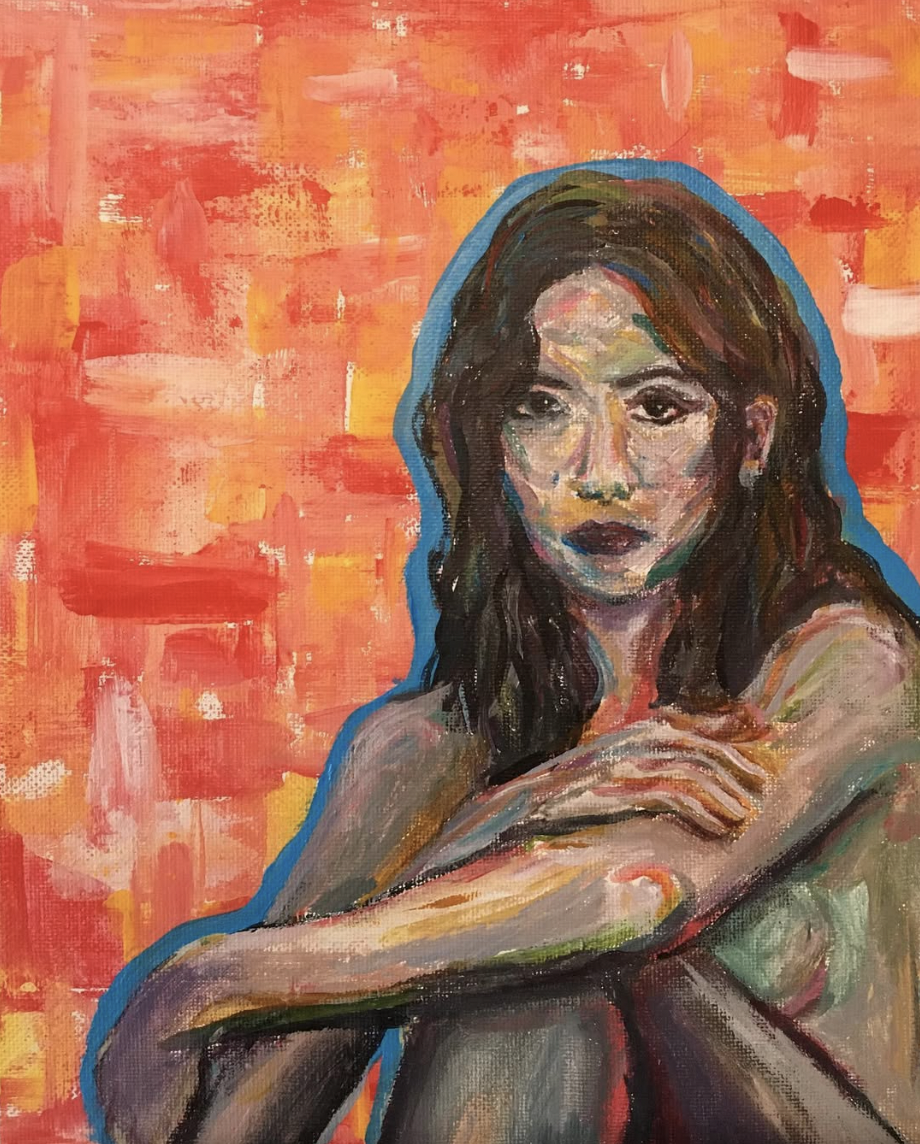
Stillness
Flore Le Blanc
A lone figure sits on the floor, gazing at the viewer with an expression between vulnerability and pain. The visible brushstrokes capture the weight of solitude, with blue hues around the figure emphasizing the stillness and melancholy of the moment. It's my hope to evoke a feeling of connection between the painting and the observer, regardless of the viewer's personal history.
.png)
Broken Spine Tacks
Brenda Lau
Pressure pain periorbital. Mid journey prompt: Elegant black and white, sideways looking right sad pretty woman, squeezing binding thick metal chain around head tied tighting it around head headache, hair dishelved, frown.

Flow
Brenda Lau
From turbulence comes calm, From chaos to flow, From restlessness to peace

Invisible Isolation
Aislinn Lavoie
“Invisible Isolation”, represents how I feel as a young woman living with many forms of chronic pain. At times, I feel trapped, like I cannot break free, as if an invisible force field is restricting me. I can see the world moving on around me, I am visible to others, and yet I am not truly seen. Physically and externally I appear as any other young woman, but on the inside, I suffer crippling and excruciating pain from a medical condition that is a mystery to most people. For individuals suffering from chronic pain, daily life is completely altered; we push ourselves to break free, but often feel trapped in a crowd of seclusion.
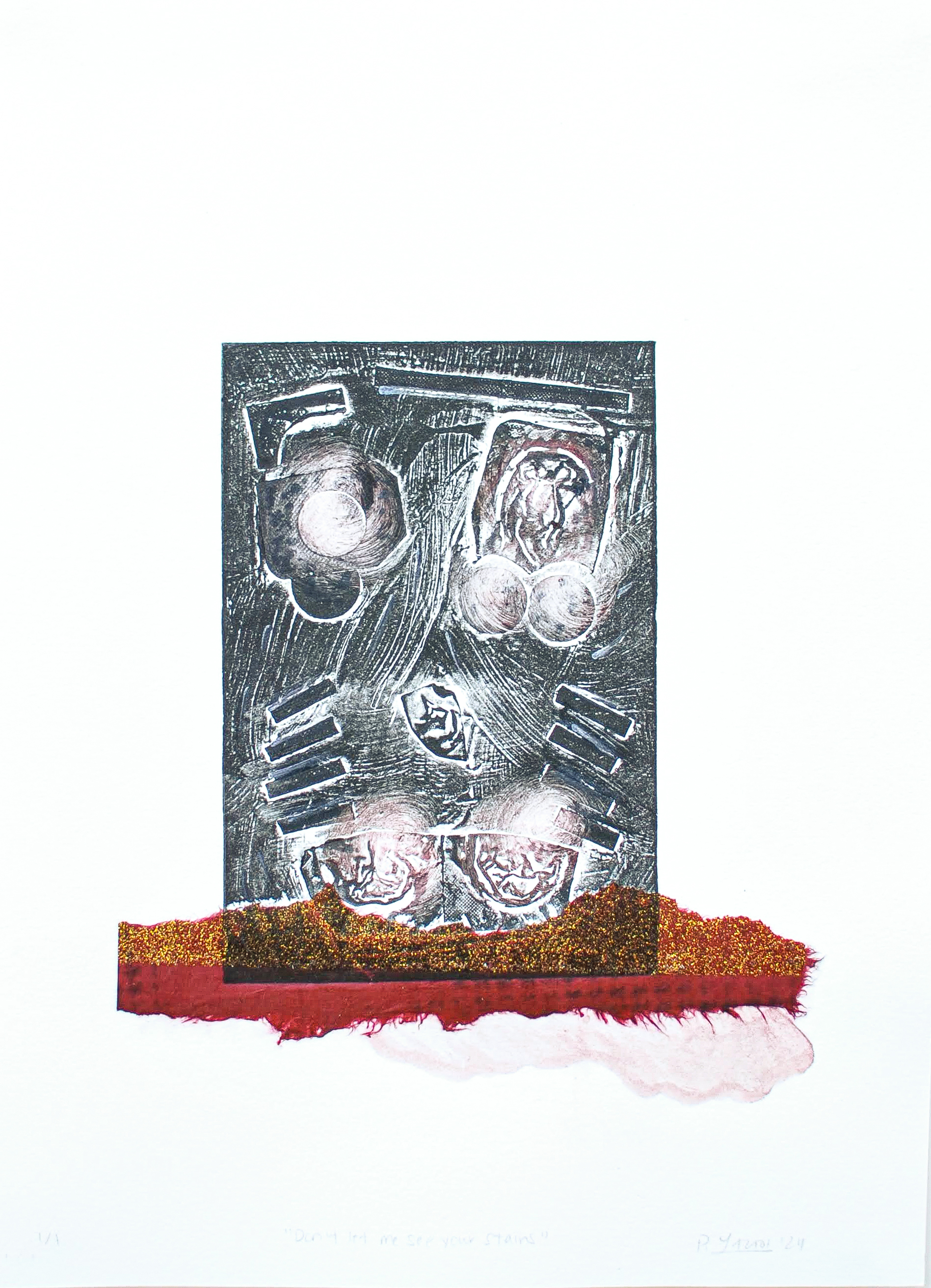
Don't Let Me See Your Stains
Pilar Lagos
A part of the “Seen or unseen” body of work. By using a strip of red glittered paper, I aim to depict the rawness and courage that it takes to be imperfectly human.

A Chat with Pain
Danielle Lewis
What I do for my pain is to speak with it; we learn from each other and heal together. We are in a relationship; we live together and have everything in common—shared experiences, thoughts, and emotions. So, we try and get along the best we can.

"Flying"
JC Little
I love the umbrella as a metaphor for agency and self-determination; in this piece I’m playing with themes of release, freedom and hope. Many of the children who attend hospital are dealing with long term illness and treatment. For my contribution to the mural at the Montreal Children's Hospital, I wanted to offer something that might spark the imagination and give a sense of wonder. Imagine if you had a magical umbrella that could catch the wind and take you anywhere you want to go? Art can take you away and the sky’s the limit.

My Mask at 16
Aarabella Lortie
This art work depicts my chronic pain and shows the tension between being myself and hiding behind my mask when I feel I can't meet societal expectations. It also shows things communicated to me by those who don't understand my disability and contrasts these with some truths and encouraging words from supporters. Making art is life-giving to me.

Shackles of White Ribbon
Rimsha Malik
In "Shackles of White Ribbon", pain is both a constraint and a catalyst for resilience. The white ribbons—tight and restrictive—reflect the coping mechanisms and facades we adopt to contain pain, even when they confine our freedom and authenticity. Yet, within this restriction, there’s a quiet strength, as if these "shackles" keep the pieces from unraveling entirely.
The hand partially covering the face represents the instinct to shield oneself, to conceal the raw vulnerability that pain exposes. However, the piercing gaze challenges this, suggesting a confrontation with pain rather than retreat. The swirling background embodies the inner turmoil—waves of anguish and resilience intermingling—showing that pain is not a static experience but an ever-shifting force.
Through this self-portrait, pain is endured, hidden, battled, and ultimately embraced as part of oneself. The painting answers: what do I do for pain? I live with it, I confront it, and I transform it into art.

Painful Isolation: The Loneliness of Chronic Pain and its Impact on Social Participation
Tharini Manikandan
My aim with this artwork is to depict the emotional terrain of suffering and disconnection. The central figure, experiencing physical unease and seclusion, stands apart from the others. Through the use of color, I have tried to capture the various emotional dimensions of pain and its impact on an individual's social interactions.

Bearing the Weight Together
Tharini Manikandan
In a world where the weight of chronic pain can sometimes feel unbearable, you can find beauty in the company, support and love. In my drawing titled "Bearing the Weight Together," the essence of empathy, support, and collective action amidst the struggle of chronic pain is captured. At the forefront of theis picture, there is a figure, burdened by the weight of an immense load. Their posture reflects the strain of carrying this heavy burden, while their expression conveys the depth of their struggle. Yet, surrounding them are figures bathed in warmth and light, their helping hands reaching out in a gesture of compassionate assistance. Each helping hand adds a burst of colour and vitality to the scene, resembling the transformative power of empathy and community. The interplay of light and shadow highlights the contrasting aspects of human existence: the somber depths of pain and adversity as opposed to the illuminating warmth of empathy and companionship. The burden is depicted with attention to detail, allowing viewers to feel its texture and weight, while the people in the artwork demonstrate that they're determined and strong even when things are tough. Through subtle symbolism and storytelling, "Bearing the Weight Together" invites viewers to contemplate the complexities of chronic pain and the importance of community in navigating life's challenges. It speaks to the universal human experience of struggle and resilience, reminding us that even in our darkest hours, we are never truly alone. While pain may be an inevitable part of the human condition, so too is the capacity for compassion and collective healing. In a world where the weight of chronic pain can sometimes feel unbearable, "Bearing the Weight Together" offers a glimpse of the beauty that emerges when we come together to lighten each other's burdens and forge shared horizons of hope and healing.

A Dream, Weightless
Soula Mantalvanos
Identity intrigues me. I choose to explore ideas of identity and self-perception. Together they represent the interconnectedness of culture, heritage and person; together, they form a complex tapestry of life experiences - my life experiences - one of which is living with chronic pain. The subject I am most familiar with is me. This self-portrait embodies all this while paying homage to the ’still life’ - a genre that inspires and propels my work.

Waves of Grief
Newton Martin
Pain hinders our ability to pay attention to the things that matter. When I feel pain I'm often anxious, desperately looking for a place to escape or withdraw. On other days I am bold and motivated to carry on despite the fatigue and stress. It is easy to see the bigger picture when experiencing acute pain and stressors, because we know it will go away soon. However, many people in the world today are in pain over-and-over again. Each painful experience becomes a barrier for people to live a full and enjoyable life.
This art piece manifests the uncertainty of long-term painful experiences. The waves of varying color signifies the emotional weight associated with our unsettling or anxious experiences. The sun adds hope to the picture because through the trashing and beating of the waves the sun never ceases to shine. When we take a step back and picture our lives from a different angle, the collage of our collective experiences becomes less of a mess and more of a masterpiece. In time, our experiences transform from being a barrier into being fuel for personal narrative and character.

Blurred Perceptions
Bianca Matthews
The awareness to action gap: a catalyst for broken promises, a blurry future, and misty realities. Otherwise known as the evidence to practice gap, this picture embodies the essence of the overproduction of pain research and a lack of the utilization of the produced evidence to create tangible solutions. The blurred horizon embodies the feeling of uncertainty in the future and uncertainty on whether or not hope is possible. The picture is taken on a Fujifilm F10 (a vintage digital camera) to simulate the fact that we are still using old pain solutions to treat new pain realities. And with that, we ignore the nuance, the diversity, and individuality in each person’s pain stories. Similar to how this photo’s graininess leads to the viewer to miss out on the intricate details of the water, beach, or horizon. The man looking at the horizon, slightly off center, is meant to embody the patients’ feeling of not having their voices uplifted and centered in our research. Without taking heed of their concerns of the lack of pain research translation, they are left gazing into blurry futures. Thus this photo highlights the importance of ensuring we are not just raising awareness, but putting our words into action to mitigate blurry pain futures.
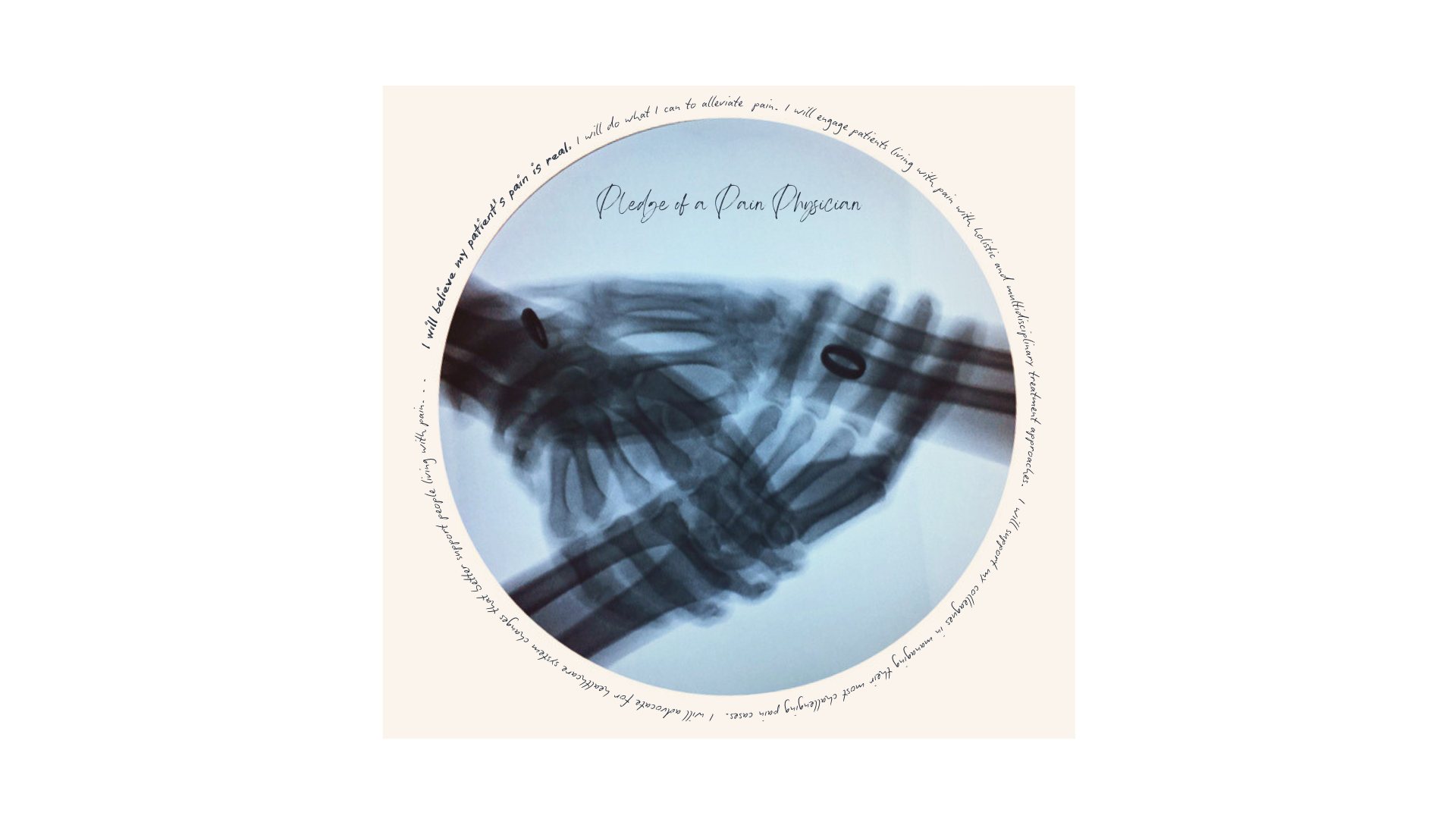
Pledge of a Pain Physician
Virginia McEwen
This image taken during my fellowship over 4 years ago captured the essence of how I felt (and still do) embarking on my journey as a new pain physician: conviction of the importance of pain medicine as a specialty, compassion for people living with pain, comraderie with colleagues with whom I share this calling, and joy in my work. The written pledge is not intended as prescriptive, rather a statement of what I hope to embody as a pain physician, and what I have seen in other pain physicians whom I look up to. . .

The Resonance of Pain
Imola Mihalecz
Pain is personal, pain is subjective, pain is abstract. Pain becomes pain through the person who lives it. Pain resonates as a multidimensional feeling. You see it, judge it, touch it, embrace it. It is more than a physiological response. It is a point of view between multiple realities.

Lost and Found
Jonie Moffitt-Falbo
Personal acrylic paintings of my journey through mental and physical pain. Pain creates a darkness. It chains the body, and entraps the mind.
My existence is dissolving, my sense of self is all but gone. Pain physically and mentally have become my jail cell. After pain management, the chains are broken, my mind begins to sense freedom and feel the light. The jail has cracked open. The pain is still there but it no longer rules me. My mind is clearer, my soul is at peace. Finally, I know I will be okay.

Patient
Cassandra Myers
Patient is a spoken word-dance video created for the UBC H.E.A.L Project which instructed doctors how to better treat their patients with chronic pain. The video details my lived experience with chronic pain alongside my chronic pain dance.

Long Horizons
Calah Myhre
This piece draws inspiration from Salvador Dali’s work The Elephants, where the march of time is depicted by long legged creatures, distorted and stretched by experience. In Long Horizons, the intertwined and elongated humans represent those with chronic pain, finding strength and resilience in community, beneath a cracked sunset.

Embodying Pain: The Connection of Body and Mind
Lindsay Neuert
Exploring the intimate relationship between physical suffering and the emotional experience of pain. The abstract composition emphasizes the neural and spinal pathways, highlighting the brain and spinal cord as central to the pain experience. The figure’s grimace expresses the profound discomfort and tension that arises from the body's response to pain. This artwork reflects the question, "What do I do for pain?" by illustrating how pain, while physical, also deeply affects the mind. Through the figure’s struggle, the piece suggests that the journey to cope with pain is a complex interaction between body and mind. By focusing on the spine and facial expression, the artwork invites the viewer to reflect on the multifaceted nature of pain and how we each respond to it in our own way.
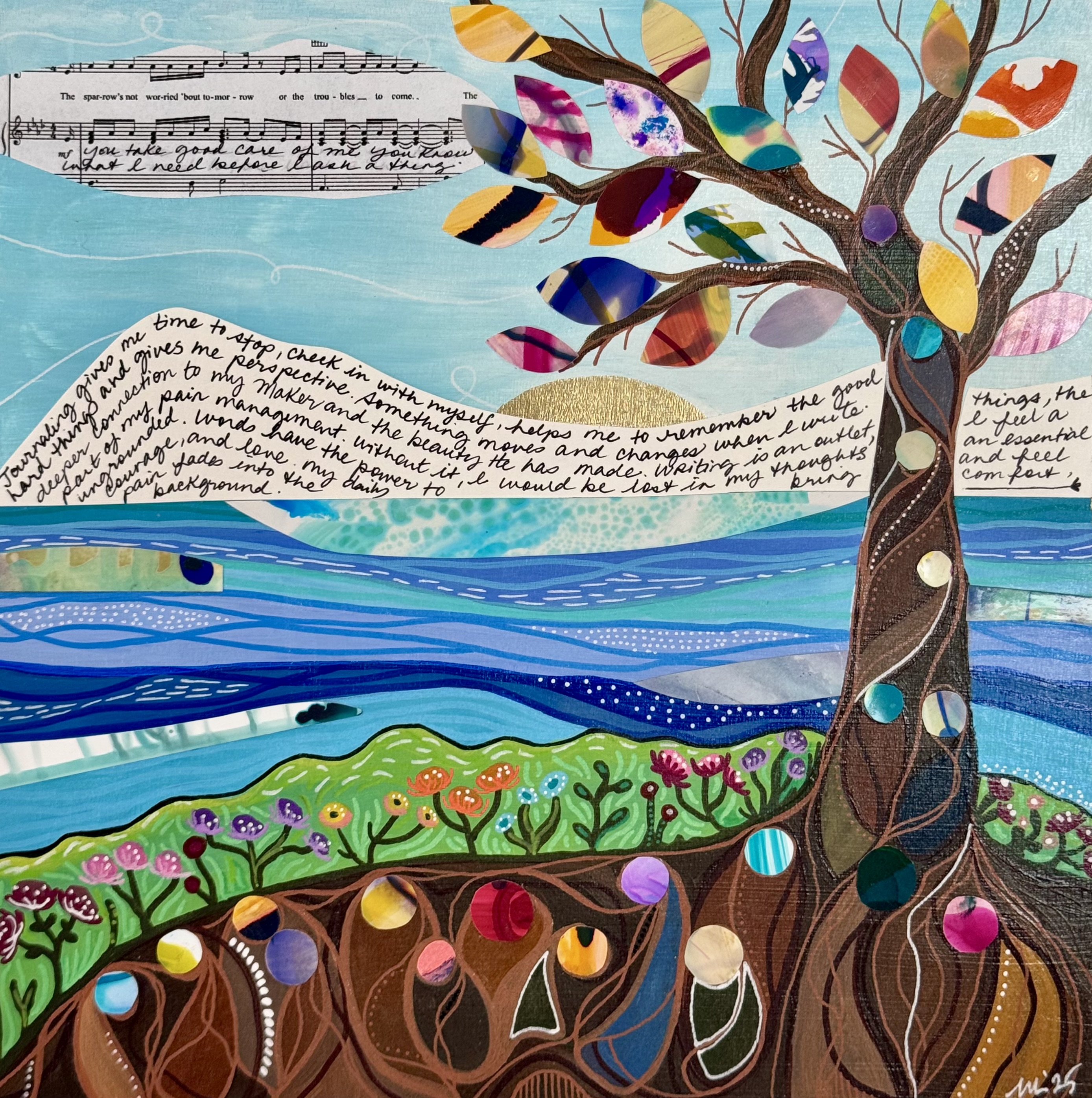
Flourishing Through Pain
Meg Neufeld
Pain is an ever-changing landscape—unpredictable yet deeply rooted in experience. 'Flourishing Through Pain' reflects my journey of learning from nature’s lessons on growth, rest, renewal, and resilience through art.
A towering tree stands strong, its vast roots symbolizing the unwavering care and love of my support system which nourishes and strengthens me. Vibrant leaves represent the bi-annual surgeries and medication that help me function daily. A mountain range serves as a reminder of perspective—journaling helps me navigate pain’s peaks and valleys—while a rising cloud embodies faith and music, lifting my spirit. The golden sun on the horizon radiates hope with every step I take. Blooming flowers inspire me to embrace creativity, enjoy the little things, and celebrate colour to boost my mood, while the ocean’s ebb and flow mirror pain’s unpredictability. These mindful elements sustain me, transforming each pain-full day into moments of strength, growth, and hope.

Captured Flashes of Lived Experience in Pediatric Pain: Illuminating the Voices of Marginalized Youth
Samantha Noyek
Pain experiences of youth with brain-based developmental disabilities are more likely to be overlooked and/or misinterpreted, especially when youth are unable to self-express their pain through speaking, writing (using paper and pencil), or typing (with a standard computer-keyboard). This video was developed through a Science Communication Course at the University of Calgary, to relay research through media. The content presents pictures and video clips that provide insight about ongoing research being led by Dr. Samantha Noyek and a team of researchers, clinicians, families, and lived experience experts. Interview clips are woven throughout to highlight pain experiences of youth and families.
The video came forth as an idea stemming from a systematic review we have conducted that maps the scope of self and observer-reported pain assessment measures of youth with brain-based developmental disabilities. Next steps of our research will provide pain assessment recommendations for this group of youth. Continued efforts will involve a World Café, bringing together diverse stakeholders to set research priorities in this area. This video was shared through social media outputs including Twitter and Facebook. The intended audience of the video includes families, researchers, and clinicians, highlighting the necessity of making this area a critical research focus

Sinus Brio and Me with errands get together go go go
Nadia Osman
My work is Drawing of my Sinus headaches. Which is typically have the following terrible symptoms: Pressure-like pain in one specific area of your face or head , Jaw, cheeks , Eyes, behind your eyes) Face is tender to the touch. Pain is worse with sudden movements of the head and bending forward. Can’t organize myself for the day and few days, uncomfortable, incomplete tasks, Shock pains all over , Feeling like missing piece of puzzle all thoughts of black all over my mind , thoughts. Trying to solve, fix, and ponder over.
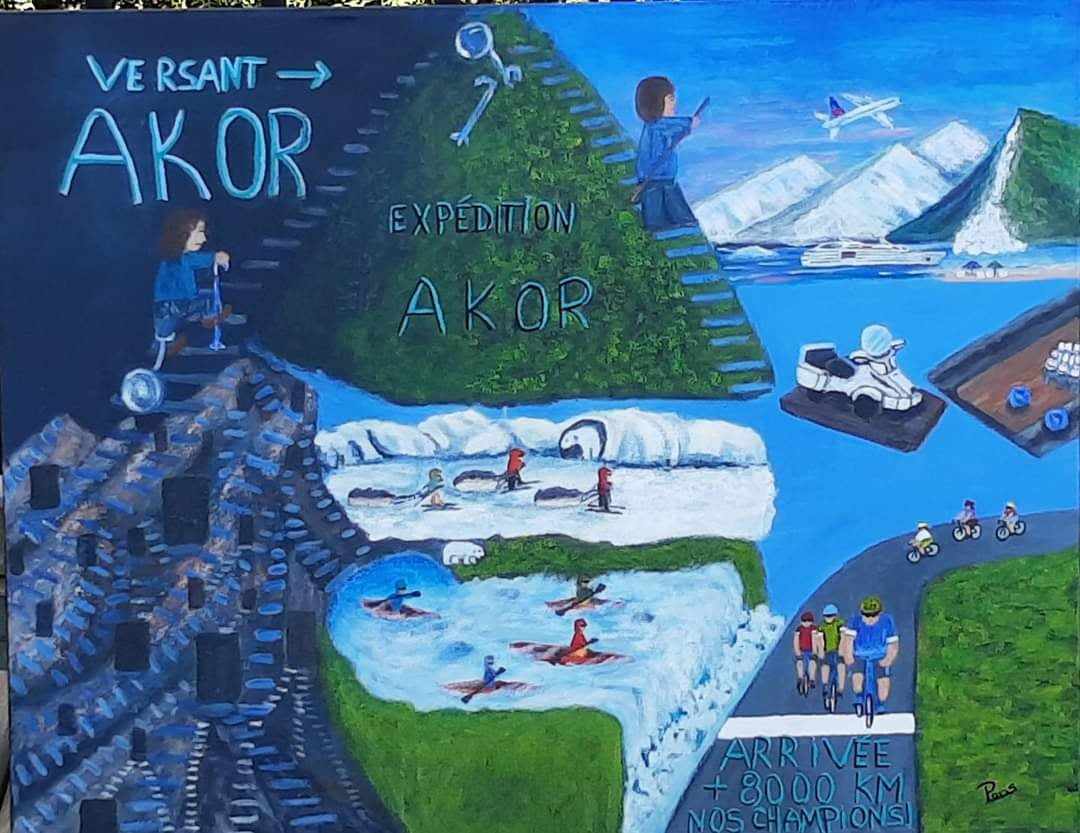
La liberté au-delà de la douleur, quelle douceur !
Carole Paris
Vivre avec la douleur, c’est comme porter un fardeau invisible, se sentir spectateur de sa propre vie, et se retrouver condamnée à l’incertitude et à la solitude. Puis, en 2021, ma vie a commencé à se transformer lentement, mais sûrement. Aux côtés d’autres personnes souffrant de douleur chronique, nous avons accepté l’invitation de notre médecin : Bouger. Ensemble, nous avons entrepris un défi ambitieux, cumuler le même nombre de kilomètres d’activités physiques à chaque semaine, que ceux parcourus par les aventuriers de l’Expédition AKOR qui traversaient le Canada du Nord au Sud au même moment. Cette toile raconte cette expérience où pendant cette association avec les aventuriers et mes collègues, nous nous sommes remis à être actifs. Nous avons traversé virtuellement le Canada et partager avec eux leurs défis, nos défis !
Pris dans un cercle de douleur, d’isolement et de sédentarité, nous avons trouvé de l’espoir en devenant des coéquipiers à distance de ces aventuriers inspirants. Tout comme nous, ils affrontaient leurs propres défis, les imprévus, les doutes et la solitude face à la majesté et à la rigueur de la nature. À travers leur aventure, nous nous sommes reconnus. Un pas après l’autre, en mouvement et reliés, nous avons compris que nous n’étions pas seuls face à la douleur chronique. Nous avons appris que nous pouvions coexister avec la douleur mais qu’elle ne définissait pas qui nous étions.
Sept mois plus tard, inspirés par cette expérience, nous avons retrouvé un nouveau versant de la vie, celui des possibilités et de l’engagement. Nous avons repris possession de notre existence, et redécouvert la joie de vivre, entourés de nos proches. Cette œuvre représente mon parcours personnel. Aujourd'hui, en tant que patiente partenaire, je souhaite offrir l’espoir à ceux qui, comme moi, cherchent à traverser leur propre versant et retrouver la lumière.

Beyond Words
Brent Parno
Throughout the last 5 years plus of dealing with many health issues, from as simple as kidney stones, migraines, constant headaches, tinnitus, to IBS, to Gilliam Barre Syndrome, constant neuropathy, Castlemans Disease, Lung Cancer, hyperparathyroidism, and FND, chronic pain is at the forefront. I hope my painting “ Beyond Words” has the power to inspire those in the health care community to truly get a small sense/feeling of what chronic pain feels like and go beyond awareness to action to help others like me find some relief/reprieve from the everyday day struggle of pain.
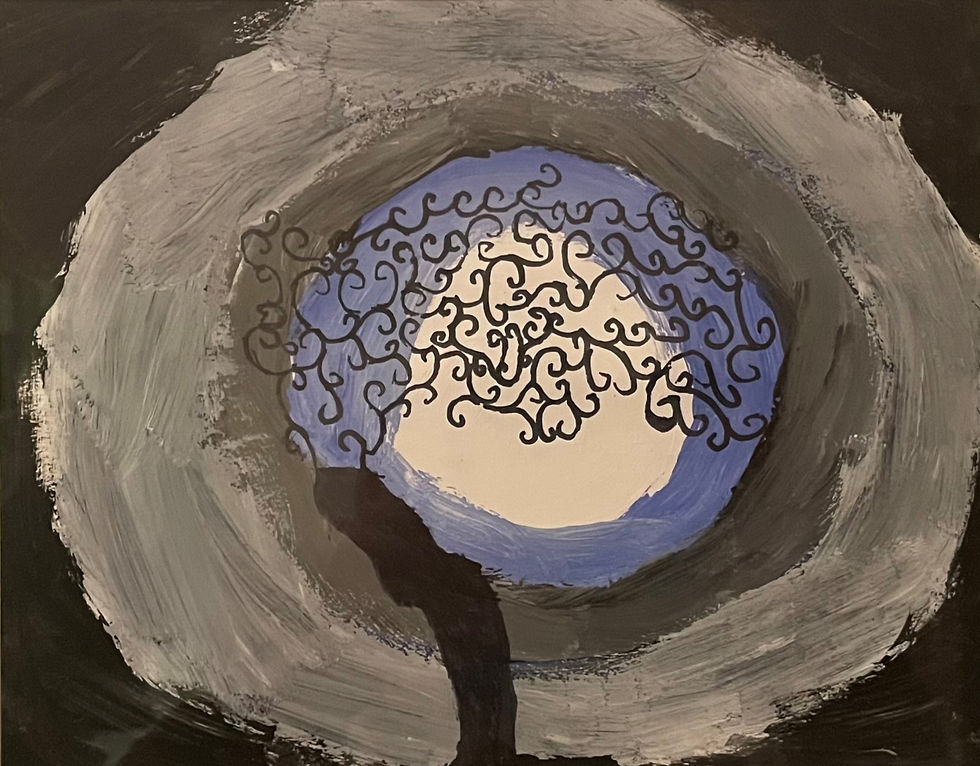
Sucked in by Pain: Reaching the Light at the End of the Tunnel.
Mathieu Piché
Pain gives the impression of imminent death, like a crooked tree that lost all its leaves. At the border of madness, the light at the end of the tunnel is there, but unreachable. Leaf by leaf, branch by branch, you break apart, stuck in an inner subspace, dissociated from reality.

Kept Hidden
Tarannum Rahnuma
My piece aims to capture the lived experiences of those with chronic pain, which affects approximately 1 in 5 Canadians. The daily struggle of managing chronic pain can make even the simplest tasks challenging, particularly in social situations where individuals may feel pressured to conceal their symptoms to avoid being stigmatized or perceived as a burden. My painting captures the emotional and physical toll of masking pain in social settings, particularly during happy occasions such as celebrations.
Through "Kept Hidden", I hope to foster greater empathy and understanding of the experiences of those living with chronic pain. I believe that by raising awareness and encouraging dialogue, we can create a more supportive and inclusive society that recognizes the challenges faced by those with pain.

From Shadows to Wings
Ginette Robitaille
What Do I Do for Pain?
As a female veteran, I carry both visible and invisible wounds. When pain becomes overwhelming, I turn to art—not just as an escape, but as a means of survival.
Painting is my meditation. As my brush moves across the canvas, my mind rewires itself. Pain fades into the background, replaced by focus, flow, and creation. Each brushstroke becomes a silent prayer, each layer a step toward healing.
My painting, From Shadows to Wings, captures this journey. The monarch butterflies symbolize resilience, reminding me that even in darkness, I can find light. The blue butterflies represent hope, a promise of renewal. Gold leaf echoes Kintsugi, the Japanese art of mending with gold, embracing scars as symbols of strength.
I turn pain into art—transforming hardship into healing. Art is my refuge, my resilience, my wings.

Peace
Paula Roumeliotis
When I am surrounded by nature I experience a deep sense of peace in my mind,body and soul and I feel grounded and connected to the earth. These peaceful feelings calm my nervous system which is a powerful self-management tool that I use to cope with living with persistent pain. In recent years, I took up photography as a hobby and I discovered a passion for it. Being creative with photography and sharing nature's beauty with others brings me great joy. This photo was taken at the Pacheedaht Campground in Port Renfrew BC.

Awakening and Choosing to exist
Anne-Marie Roy
Through my practice as a physiotherapist, I see people isolated with their chronic pain. The price for a simple outing is too high and the recovery time, too long. The isolation comes for many reasons, for example the physical limitations, feeling annoying with the complaints or just misunderstood. All though they avoid talking about it, they burn inside and want to express it as LOUD as they can. But they don’t… Until, they realize how much the pain is ruling their lives. Then they make different choices. They cannot act as if it doesn’t exist, so they act accepting that part of them. I see them changing their view on things, seeing the suffering more as a quest to find themselves again. They switch a bit the ultimate goal. It becomes more about fulfilment than pain. They share their experiences through different activities either in a group or a personal practice like art. They learn to live their lives differently. They learn to love themselves again, not in spite of the pain but regardless of it. Their journeys are long, hard and sinuous but at the same time beautiful and inspiring.

Comfort/Discomfort
Suha Sagheer
Someone close to me once described living with chronic pain as being an isolating and lonely experience. Yet, the social and familial support they received on a day-to-day basis helped them to get through the day. Here, I used abstract lines and contrasting colours to depict the comfort from social support in the midst of experiencing the discomfort of living with pain.

Self-deception
Rabia Salman
This photograph depicts a visual of deflecting the mind’s attention from one source of pain to another less afflicting version of it. This phenomenon known as “conditioned pain modulation” (CPM) describes applying painful stimuli to a part of the body that decreases the perception of pain elsewhere. The pain inflicted by jabbing fingernails into one’s palms refocuses the mind's attention, deceiving it to focus on the more bearable pain that is within its own control. I discovered this was a coping mechanism I was using unconsciously against chronic migraine pain. The darkness surrounding the hands symbolizes “the aura” experienced before a migraine. Blur and motion delay of the hands is used to illustrate the countless attempts to gain control over one’s pain. The red sweater portrays anger felt towards the body for hurting itself, meanwhile the blue background mirrors the deep fragility and sadness that comes alongside chronic pain.

This is EPIC: simulation Education regarding Pain to Improve Care
Monakshi Sawhney
Simulation education, using standardized patient actors is a unique way to provide pain management education in health care settings to practicing clinicians. It is an opportunity to practice assessment skills and critical thinking in a safe environment that mimics the patient care setting. Our team implemented this concept at a hospital in Canada with a focus on researching the outcomes of a simulation intervention for nurses who care for patients receiving epidural analgesia for pain management after surgery. This photograph depicts the real to life patient care environment that was created for this study.
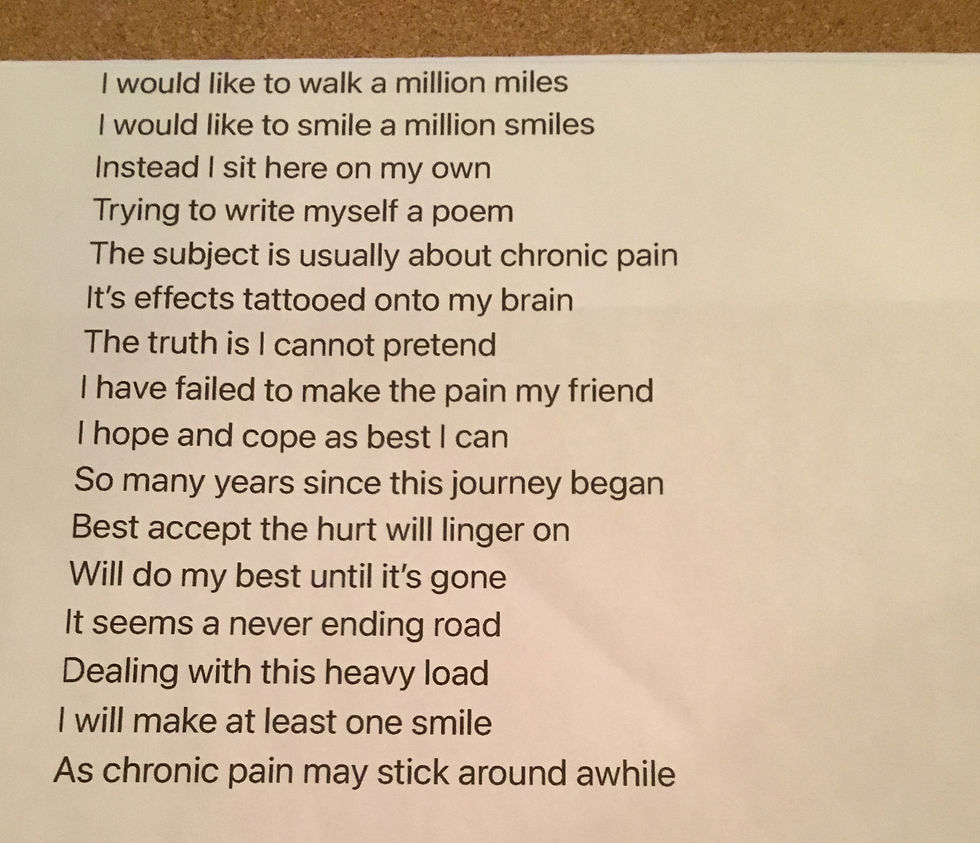
A Million Miles
Ilsa Sejean
Poem living with chronic pain

Mon tronc
Donald Sergerie Jr.
D’arbre rabougri de par son tronc aigri, les douleurs chroniques ne sont que sablier, s’égrenant que très peu lentement, où les jours défilent au même rythme que la nouvelle feuille s’étant pointée le bout du nez dans mon "money tree" ce matin, où rêves et racines s’accrochent à la vie, mais que difficilement parfois. Et à travers les rictus et autres faciès où les maux trouvent écho, et malgré les ciels plus souvent qu’autrement sombres et orageux, kizis arrive toujours à caresser la joue de ses premiers rayons du printemps, tendre attention permettant d’en respirer tous les arômes du moment présent.
Deej@2025

Decoration/Deterioration
Lucy Sharpe
One of the most isolating factors of chronic pain for me is that my condition is not visible. Last year I had a particularly bad flare up. Standing, sitting, pretty much anything that wasn’t lying down caused shooting nerve pain. It was so strange to be so consumed by it while doing everyday things like going to class and shopping for groceries. There was such a profound disconnect between my interior experience and the way I was being perceived. This painting is my attempt to externalize these feelings. I wanted to paint something confronting, that forced people to think about their own relationships to their bodies.
The only way I have found to successfully navigate the world in while in pain is to be endlessly compassionate towards my body and it’s needs. This is not always easy: Pain makes me angry, and sad, and often ungenerous towards myself and others. The little hair clips and the string of pearls represent the little things I do to care for myself and remind myself of the beauty and capability of my body. It was important to me that I represent both the pain and the care in this piece.

Chronic Invisibility
Patricia Simmons
Chakras correspond to the energy centres located in the body that affect our emotional and physical wellbeing. Balance and openness are key. The major chakras are often represented by seven colours ordered vertically. In Reiki, a pendulum held over a chakra moves clockwise to indicate that it’s open, counterclockwise to indicate closed, and in a straight line to indicate half-open/closed. My chakra colours are disordered, and my circular and linear brushstrokes mimic the movements of the pendulum. I gestured towards a dysregulated body and the constant struggle to establish balance.
The globe/eyeball suggests that each person is a world unto themselves, an internal mystery that cannot readily be apprehended or measured. So much is going on behind the eyes, in the body, in the mind. The shadow of my hand turned upward is at once a site of pain and a gesture of reaching for help.
The seven colors associated with the major chakras correspond to the seven colors of visible light. While they function almost metaphorically in the chakra system to render visible the light within, invisible energy, I have used the chakra system and its colors to render visible another kind of invisibility—the subjective experience of pain.
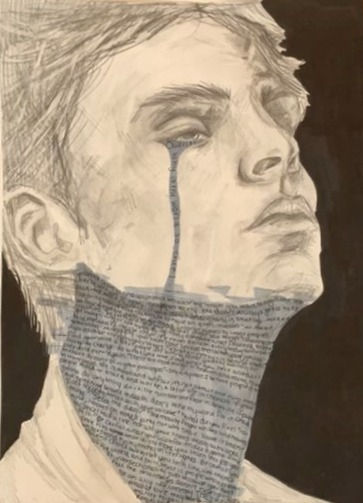
The Solitudes of Pain
Lesley Singer
My granddaughter sketched this at school and when I saw it it made me think of the social isolation of youth in pain

Things that fall apart may yet stay together
Physio Sparks
This drawing features a fractured, mirror-like body symbolizing the fragmentation of one’s sense of self due to pain. At its heart is an African woman, embodying both vulnerability and resilience as she navigates the burden of chronic pain. Her fragility highlights the disproportionate suffering faced by individuals with Sickle Cell Disease (SCD), a disease as devastating and widespread as Cancer, yet often overlooked.
Despite recent advancements in pain management, significant challenges remain. The American Society of Hematology (ASH) has developed comprehensive guidelines, but many patients still face barriers such as limited access to specialized care and a lack of understanding about SCD pain. The emotional and psychological impact on patients and their families is often underappreciated.
Canada has made strides through initiatives like the Sickle Cell Disease Association of Canada (SCDAC), research programs, and newborn screening. However, gaps persist, including inconsistent screening, limited specialized care, and insufficient public awareness.
International collaboration, especially with low- and middle-income countries in Africa, is crucial. Sharing knowledge, enhancing research, and improving access to care can significantly impact SCD management globally.
Recent advancements have brought hope with the Food and Drug Administration (FDA) approval of ground-breaking gene therapies, which represent potential cures for SCD. These therapies use gene-editing technology to modify a patient's own stem cells, offering a promising solution. However, their high cost may limit accessibility for many patients.
This artwork underscores the intersectionality of pain, acknowledging the complexities faced by those with SCD. It invites viewers to reflect on the multifaceted nature of pain and to laud the remarkable resilience of those who endure it.

The Trigeminal Tree: Medication, Music, and Nature
Isabella Spensieri
I live with trigeminal neuralgia, and there are three main ‘tools’ that I use for pain: pharmacological interventions, listening to music, and being in nature. To illustrate these ‘tools,’ the painting showcases a tree. Depending on your viewpoint, it can also look like a head and neck. At the bottom of the tree are rocks, which are old pill bottles of mine. The tree’s leaves are made from my pill bottle labels, medication paper bags, and used pill packaging; if you look closely, you can see various medication names. Another 3D element is the symbolic pair of trigeminal nerves; these ‘nerves’ are made from real tree branches that I’ve painted. There is a syringe in the top right, to represent trigeminal nerve blocks that I frequently receive. Finally, music notes flow out of one prescription bottle, showing that soothing pain involves more than medication.

Constellations of Chronic Pain and Depression Research: A Network Visualisation
Abhimanyu Sud
People living with chronic pain often experience depression, but understanding and treating these two conditions together can be very difficult.To get a better idea of which treatments might improve depression for people with chronic pain, systematic reviews have been conducted to compile results from multiple clinical trials.
These reviews usually focus on one type of chronic pain or a certain kind of treatment.
An umbrella review then compiles the results from multiple systematic reviews, to get the broadest possible picture. An umbrella review can tell us what kinds of treatments have been studied for the effects on depression, and for what kinds of chronic pain conditions.
This network visualization shows a constellation of 83 systematic reviews (grey dots), and the 459 clinical trials that they synthesise (blue dots when included by one systematic review; green dots when included by more than one). Looking at the network of systematic reviews and clinical trials, we identified groups based on types of treatments (labels and outlines) and kinds of chronic pain conditions (coloured clouds).
This network visualization provides a big picture view of research on depression and chronic pain, and the gaps that are worth investigating in future studies and reviews.

There Are Choices
Hafsah Syed
This photograph was received as part of my study, supported by the University of Calgary, Mitacs Research Training Award, and the Mabbott Leadership Award. Participants with chronic pain were invited to take digital photographs to represent their lived experiences, through a methodology called photo-elicitation. We explored the relationship between chronic pain and animal companionship. A human-animal bond may shape the experience of living with chronic pain; one participant— with 10 years of chronic pain— shared this photograph and elaborates:
"He never leaves my side. He's saved my life, in more ways than one. There are choices to live or die. Whether to take your life or not— there's always a choice— but my dog is my choice to stay here. To me, the medications are a way out of the pain— I've got so many lying around the house, it's very easy to take them all— but he's always here for me. [My psychologist] asked me 'what keeps you here?' It's my dog, 100% of the time. He doesn't know— he would just never see me again, and that would be the worse thing ever— that keeps me from doing anything. There are choices and, hopefully, always the right one."

Together
Doriana Taccardi
Before starting my career as a researcher in Chronic Pain, I worked as a clinical assistant. One of the people I came in contact with was a young woman in her 20s, she had a Traumatic Brain Injury that resulted in chronic pain.
She was very energetic and curious, but her pain often too intense to allow her to do what she wanted to do. Her family did not really understand her condition. She felt lonely and misunderstood. She had sorrow in her eyes, but was able to hide it with a smile. I introduced her to a Brain Injury charity, she met virtually with them, they were sharing their stories every week. When her pain was too intense, she wanted to join the weekly meeting with her camera off to listen to their stories anyway.
This poem and artwork is about her and what she taught me about living with chronic pain, about the importance of surrounding yourself with people who can understand your sorrow, or maybe can't completely understand but are able to be there for you. Sometimes you don't need to do something or change something, you just need to be there for someone.

Me and Migraine, no matter the weather
Bonnie Thompson
Here I am on holiday on Vancouver Island with a migraine. No matter my condition or the weather, I sit outside. I bathe myself in the elements, allowing the wind, the sun, the snow, or the rain to wash over me.

Turning to Stone
Terry Wilde
My late wife Lili Painted this in 2003 after full body Chronic Regional Pain Syndrome (CRPS) set in, triggered by a car accident in 1999. She had full-bodied Pain except in the left side of her face. At this point in her life she had no tolerated pain medications due to severe allergies. Suicide or Medically Assisted Death was a constant battle.
This Image depicts the struggle with pain and loss of ability, while showing the life in the left side of her face, the one place she could escape to. After many years of struggle and Healthcare Harm, she died in 2019 with a strong will to live.

Death’s Embrace
Terry Wilde
Death’s Embrace was painted by the late Lili wilde who lived with 3 rare disorders including full body CRPS a high level pain disorder. Lili was a strong advocate for herself and other patients around the world, but face to face social interaction was a challenge with her medical conditions. This painting depicts her experience of death constantly looking over her shoulder, her one constant companion. Like Lili, many patients with pain disorders and chronic conditions, face chalenges maintaining a social life. Death was a reality that Lili had to face, much sooner them she should due to her conditions and healthcare harm.

Entangled: Persistent Pain and Mental Health
Sandra Woods
Chronic pain affects more women than men. We don’t know why, because past research has mostly involved men. Added to that historic unfairness, women’s pain has often been ignored or even disbelieved by doctors and nurses. So many women in pain end up feeling traumatized, simply from trying to get medical help with their pain.
Constant pain can interfere with your sleep, concentration and focus, ability to plan your daily tasks – and sometimes your ability to look after yourself and your loved ones. You might have to cut back on your work hours, or to stop working altogether.
These are just a few of the impacts of chronic pain on a person’s life. Pain can lead to financial problems, unstable housing, child custody issues, and more.
It’s no wonder that many people who live with pain also have mental health problems.
This painting is meant to show the different mental health burdens caused by chronic pain…
The pain itself, always there, and worries about the future:
Will the pain ever end? What will be the impact of pain on your family, finances, friendships, job, or studies? How can you explain your pain to others, if they can’t even see it?

One in five Canadians … lives with chronic pain
Sandra Woods
Although it’s estimated that One in Five Canadians lives with chronic pain, this condition is often linked with social isolation. We might say that “misery loves company”, but no one really wants to listen to someone talk about their persistent – ongoing and possibly permanent – pain. So the person in pain becomes a pariah, the one left alone at social events – if they’re invited at all. In this image the background flame depicts the burning pain of Complex Regional Pain Syndrome (CRPS), with One in Five consumed by this orange fire. Of the Four blue figures, representing cooling comfort, all but One are looking away from the person in pain – ignoring their distress. It takes only One to provide comfort, and hope. Be that One person.
Catégories de soumission
Vous pouvez soumettre vos œuvres dans l'une des quatre catégories suivantes : visualisations scientifiques (par exemple, IRM, microscopie), formes d'art classique (par exemple, dessin, court poème/récit), ou photographie, vidéo et musique.
Prix
Les 20 meilleures candidatures toutes catégories incluses, sélectionnées par notre jury du concours d’art, seront présentées sous forme imprimée lors de notre réunion scientifique annuelle à Québec. Découvrez les soumissions précédentes!
Vote
Le vote pour désigner les lauréats de cette année revient aux membres de la Société canadienne de l'étude de la douleur ! Le vote est ouvert du 1er avril au 1er mai. Vous n'êtes pas encore membre?
Partagez votre art
Exigences en matière de téléchargement
-
Nommez le fichier uniquement avec le nom complet de l'artiste (par exemple, SarahJohnson).
-
La taille du fichier envoyé ne doit pas dépasser 25 Mo.
-
Une seule participation par artiste.
-
Familiarisez-vous avec nos directives de soumission.
Les téléchargements de photos requièrent
-
Une composition claire de la photo : Veillez à ce que votre zone ne soit pas obstruée.
-
Un éclairage optimal : La photo est bien éclairée et ne comporte pas d'ombres.
-
Recadrage réfléchi : Prenez le temps de recadrer votre photo, en vous concentrant sur le sujet principal et en éliminant les éléments distrayants de l'arrière-plan.
Digitale
-
Veillez à ce que la résolution minimale soit de 300 DPI pour une impression de haute qualité.
Vidéo
-
Le cas échéant, veuillez inclure les avertissements concernant les lumières clignotantes, les effets sonores surprenants, etc.
-
Veuillez désigner et télécharger une vignette qui servira à afficher votre travail sur les mises en page qui ne permettent pas l'utilisation de la vidéo

